All posts by Andrea Grant
About Andrea Grant
Andrea Grant is a Children's Services Specialist. View all posts by Andrea Grant →
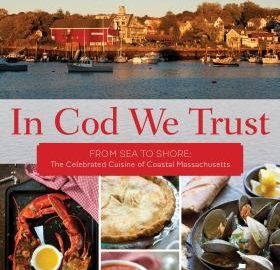
Bibliobites in June: The Home of the Bean and the Cod*
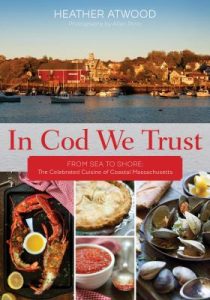 Ahh, home sweet home! This month our group stayed local with Heather Atwood’s In Cod We Trust: The Celebrated Cuisine of Coastal Massachusetts. This 2016 title takes us on a tour of our very own coast, from Provincetown to Newburyport, New Bedford to Nantucket. Though Yankee cooking, in its inimitable Rodney Dangerfield way, gets little respect for its sturdy plainness and extreme thriftiness, it’s these very qualities that likely account for its stubborn longevity. And, many of our local delicacies (like the aforementioned bean and cod) are infinitely adaptable to new ingredients brought by immigrants from all over the world. So perhaps our definition of Yankee fare needed some updating.
Ahh, home sweet home! This month our group stayed local with Heather Atwood’s In Cod We Trust: The Celebrated Cuisine of Coastal Massachusetts. This 2016 title takes us on a tour of our very own coast, from Provincetown to Newburyport, New Bedford to Nantucket. Though Yankee cooking, in its inimitable Rodney Dangerfield way, gets little respect for its sturdy plainness and extreme thriftiness, it’s these very qualities that likely account for its stubborn longevity. And, many of our local delicacies (like the aforementioned bean and cod) are infinitely adaptable to new ingredients brought by immigrants from all over the world. So perhaps our definition of Yankee fare needed some updating.
It turns out that the author of this book, Heather Atwood, is first and foremost a food historian and author. Chapter headings are loaded with information about a particular locale and its residents, and sidebars in most chapters showcase an area’s restaurants, farms, or noteworthy ingredients. Many recipes have longish headnotes about where the dish may have originated, and/or its variations. In a way this book is a tempting travelogue; if you lived somewhere else, the charming descriptions and evocative photos might have you booking a flight ASAP. Unfortunately, some of the places mentioned no longer exist, leaving us only wishing we’d been able to check them out.
 The book is arranged by region; for instance, there are chapters devoted to the south coast, or Cape Ann. At first blush this might seem sensible and even enjoyable, but for those of us actually cooking from this title, it quickly became an exercise in frustration and endless page flipping. If you wanted to find a particular fish dish (for example), you pretty much had to remember which section it came from. Why not consult the index? Good question, and the answer is that the index is the worst any of us had ever seen. Even if you had the exact name of a recipe, it often could not be found in the index. Especially in a title that’s not organized by main ingredient or by part of the meal, the index is vital. So perhaps we were a bit grumpy as we headed into the kitchen– did our efforts manage to soothe our souls? Or at least provide us with something delicious for dinner?
The book is arranged by region; for instance, there are chapters devoted to the south coast, or Cape Ann. At first blush this might seem sensible and even enjoyable, but for those of us actually cooking from this title, it quickly became an exercise in frustration and endless page flipping. If you wanted to find a particular fish dish (for example), you pretty much had to remember which section it came from. Why not consult the index? Good question, and the answer is that the index is the worst any of us had ever seen. Even if you had the exact name of a recipe, it often could not be found in the index. Especially in a title that’s not organized by main ingredient or by part of the meal, the index is vital. So perhaps we were a bit grumpy as we headed into the kitchen– did our efforts manage to soothe our souls? Or at least provide us with something delicious for dinner?
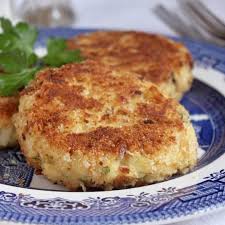 As expected, there were plenty of seafood recipes from which to choose. Two people tried Mondello’s fish cakes which were a “good, solid version” of this classic homey dish, containing the usual suspects of cod, potatoes, egg, and breadcrumbs. The recipe makes a good-sized batch, but they aged surprisingly well in the fridge, and can also be frozen. Fluke (or flounder) beautiful was “really delicious” and visually appealing with its tomatoes, olives, and parsley; a garlicky white wine sauce brought all together harmoniously. Two cooks took the time to put together cod a braz, a bit of a production involving fried potatoes, braised cod, eggs, and a cherry tomato relish. The relish was the best part of the dish by far, and would go with just about anything that could use a savory, acid foil. A keeper! Molho de tomate was another super tomato recipe that would be terrific with fish. This easy, long-simmered sauce had plenty of savory flavor from garlic and red wine; vinegar and pepper flakes added “a bit of a kick.”
As expected, there were plenty of seafood recipes from which to choose. Two people tried Mondello’s fish cakes which were a “good, solid version” of this classic homey dish, containing the usual suspects of cod, potatoes, egg, and breadcrumbs. The recipe makes a good-sized batch, but they aged surprisingly well in the fridge, and can also be frozen. Fluke (or flounder) beautiful was “really delicious” and visually appealing with its tomatoes, olives, and parsley; a garlicky white wine sauce brought all together harmoniously. Two cooks took the time to put together cod a braz, a bit of a production involving fried potatoes, braised cod, eggs, and a cherry tomato relish. The relish was the best part of the dish by far, and would go with just about anything that could use a savory, acid foil. A keeper! Molho de tomate was another super tomato recipe that would be terrific with fish. This easy, long-simmered sauce had plenty of savory flavor from garlic and red wine; vinegar and pepper flakes added “a bit of a kick.” 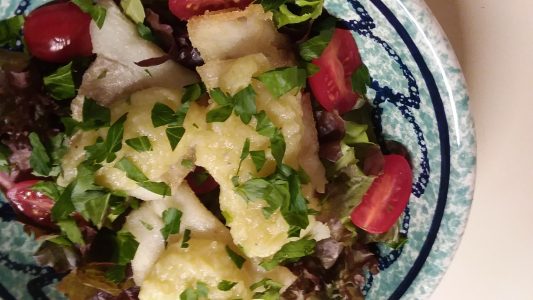 Fried cod squares with whipped potato, garlic, and olive oil dressing was yet another riff on the fish/potato combination. This iteration was a bit dressier than most, with an unctuously smooth potato and olive oil sauce dolloped atop the fried fish. The contrast of crunchy yet tender fish and the silky sauce was almost worth the effort, “I might make again!”
Fried cod squares with whipped potato, garlic, and olive oil dressing was yet another riff on the fish/potato combination. This iteration was a bit dressier than most, with an unctuously smooth potato and olive oil sauce dolloped atop the fried fish. The contrast of crunchy yet tender fish and the silky sauce was almost worth the effort, “I might make again!”
In the shellfish department, Rockport lobster roll was “your basic lobster roll,” which isn’t a bad thing. This particular recipe includes minced celery, which apparently is against the laws of nature in some lobster-loving locales. You are forewarned! Scalloped scallops had a “delicious flavor” with plenty of butter and a nice hit of salt from the crackers. The called-for saltines did get soggy; a few in the group mentioned that Ritz crackers are a better choice in such situations. Mussels mariniere featured a twist on this traditionally brothy dish: a creamy, buttery roux-based sauce. Our cook found this “easy, but too rich….[and] a mess to eat.” 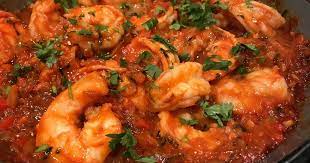 Portuguese spicy shrimp showcased an ingredient that we weren’t familiar with: pimenta moida, a spicy sauce made of red peppers fermented with salt. It’s not something that’s commonly found in supermarkets, so our cook made do with chili sauce. Garlic, smoked paprika, and white wine added complexity for a quick, easy, and zippy dish.
Portuguese spicy shrimp showcased an ingredient that we weren’t familiar with: pimenta moida, a spicy sauce made of red peppers fermented with salt. It’s not something that’s commonly found in supermarkets, so our cook made do with chili sauce. Garlic, smoked paprika, and white wine added complexity for a quick, easy, and zippy dish.
There were several vegetarian possibilities: morning glory farm’s corn and wild mushroom risotto was a solid, if not very inventive, choice. At our meeting we sampled 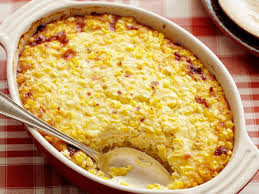 1874 nantucket corn pudding, a large, extremely corny casserole that did seem “very Yankee.” This was tasty, but our cook had a few complaints: the dish size called for was way too small, and the cooking time was wildly underestimated. Mildred justice’s golden puddding was a similar idea, featuring carrots, corn, and squash bound with eggs, milk, and cornmeal. Ground allspice was an inspired touch that lifted this dish from ordinary to differently delicious. Leftovers kept well. Blueberry and butternut squash salad with dried blueberry vinaigrette (this book seemed to have a lot of very long recipe names!) was your basic hearty, main-dish salad; but what really kicked it up a notch was the fantastic dressing, “delicious!” Kale salad with miso dressing and spiced pecans also had a “great!” dressing, “I didn’t expect to like it– but I did!” Mango, avocado, and dried cranberries added enjoyable flavors and textures. Since June is strawberry season in these parts, one cook made
1874 nantucket corn pudding, a large, extremely corny casserole that did seem “very Yankee.” This was tasty, but our cook had a few complaints: the dish size called for was way too small, and the cooking time was wildly underestimated. Mildred justice’s golden puddding was a similar idea, featuring carrots, corn, and squash bound with eggs, milk, and cornmeal. Ground allspice was an inspired touch that lifted this dish from ordinary to differently delicious. Leftovers kept well. Blueberry and butternut squash salad with dried blueberry vinaigrette (this book seemed to have a lot of very long recipe names!) was your basic hearty, main-dish salad; but what really kicked it up a notch was the fantastic dressing, “delicious!” Kale salad with miso dressing and spiced pecans also had a “great!” dressing, “I didn’t expect to like it– but I did!” Mango, avocado, and dried cranberries added enjoyable flavors and textures. Since June is strawberry season in these parts, one cook made 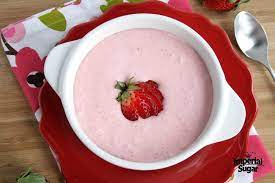 rosalie’s chilled strawberry soup, a very pleasant, cooling concoction of wine-marinated berries, sugar, and yogurt. We sampled this at our meeting and it was a winner! The red wine was the perfect accent, bringing all the flavors together without dominating. There was some discussion about what to do with the extra wine (the recipe only needs a cup or two). Hmm… not really a problem!
rosalie’s chilled strawberry soup, a very pleasant, cooling concoction of wine-marinated berries, sugar, and yogurt. We sampled this at our meeting and it was a winner! The red wine was the perfect accent, bringing all the flavors together without dominating. There was some discussion about what to do with the extra wine (the recipe only needs a cup or two). Hmm… not really a problem!
Despite the heat, a few people still felt the need to bake. Mermaid farm milk ricotta and lemon muffins looked unappealingly pale, but they were yummy and tender with just-right lemon flavor. Can’t judge a muffin by its cover? Old-time blueberry grunt was also a fairly homely looking dessert, and was a grunt of a different sort. Most of us had the impression that a grunt is very similar to a cobbler, but this version is more like British summer pudding, in which cooked fruit is mixed with chunks or slices of bread and then chilled. Though the texture of this dessert was a bit unusual, you can’t go wrong with blueberries and sugar. And 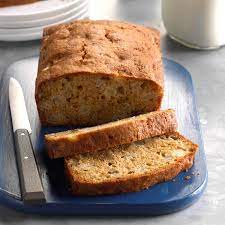 pear walnut bread was definitely a keeper, “I liked it so much I made it twice!” The chopped pears added subtle moistness and quiet flavor, and the classic combination of cinnamon and nutmeg was the perfect accent.
pear walnut bread was definitely a keeper, “I liked it so much I made it twice!” The chopped pears added subtle moistness and quiet flavor, and the classic combination of cinnamon and nutmeg was the perfect accent.
Despite a few keepers, for all of us, this book failed to impress. It seemed fairly dated, and many of the recipes (with some notable exceptions) seemed a bit too ordinary. And there were enough complaints about timing and directions that made us wonder if some of the recipes had even been tested. While the author’s stories and history are fun to peruse and make for good conversation, in a cookbook we also want stellar food, and for us this book mostly didn’t have it. And, the annoyances of the book’s organization and the atrocious index didn’t help matters. So, perhaps unsurprisingly, our rating averaged out to just a hair under 2 (out of a possible 5). Ouch! That might be our lowest score ever.
June marks the end of our Bibliobites “year.” We’ll take a break until September, when we’ll meet on the 29th at 11 AM in the Fireplace Room. Enjoy the summer, and see you in the fall!
*From a bit of doggerel attributed to Holy Cross alum John Collins Bossidy (1910):
“And this is good old Boston/The home of the bean and the cod,
Where the Lowells speak only to Cabots/And the Cabots speak only to God.”
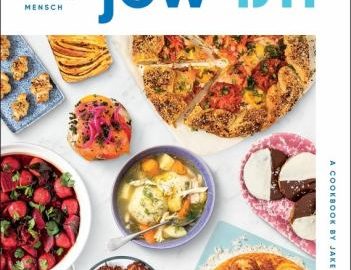
Bibliobites in May: “-Ish” Again
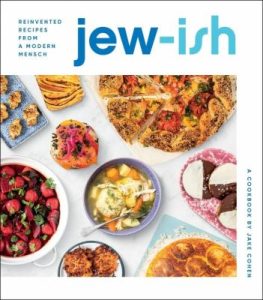 The melting pot* that is America is never more beautifully expressed than in its foodways. Sure, it’s easy to poke fun at our love of fast food and fried everything; but the variety of cultures represented in our supermarkets and on our plates is astounding. Ingredients that a few years ago might have been looked upon with some puzzlement (“what is that??”) have quickly become standard items in our pantries. Think fish sauce, gochujang, miso, za’atar, tahini, endless varieties of chutney– and that’s just condiments! So, it can certainly be argued that every day, Americans embrace the ish. We may cook Indian-ish or Greek-ish or Thai-ish without a second thought, and our ish may extend to creating dishes that meld familiar foods from our own backgrounds with those of other cultures.
The melting pot* that is America is never more beautifully expressed than in its foodways. Sure, it’s easy to poke fun at our love of fast food and fried everything; but the variety of cultures represented in our supermarkets and on our plates is astounding. Ingredients that a few years ago might have been looked upon with some puzzlement (“what is that??”) have quickly become standard items in our pantries. Think fish sauce, gochujang, miso, za’atar, tahini, endless varieties of chutney– and that’s just condiments! So, it can certainly be argued that every day, Americans embrace the ish. We may cook Indian-ish or Greek-ish or Thai-ish without a second thought, and our ish may extend to creating dishes that meld familiar foods from our own backgrounds with those of other cultures.
This month’s title, Jew-ish by Jake Cohen, perfectly exemplifies how a cultural mashup expresses itself through food. Jews have lived in every corner of the world and have adopted and adapted foods from wherever they have been. If (like me) you grew up in the New York metro area, you are very familiar with the chicken soup-kugel-latke style of Jewish cuisine, but there’s a lot more to it than that, as we discovered once we got into the kitchen. Did we find out that we want to add another ish to our repertoire?
This book grew out of the author’s custom of hosting Shabbat** dinners; accordingly, many recipes are designed to serve 8. This required a bit of math on our parts, since most of us live in smaller households and aren’t hosting dinner parties on a regular basis. But, since we must eat dinner every night, we dove in regardless: four people were intrigued by Iraqi roasted salmon with tomato and lemon. This was a hit for most who tried it; the combination of savory caramelized onions and acidic tomato/lemon topper was the perfect foil for rich salmon. 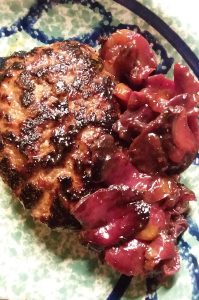 Lamb chops with crushed grapes and sage was a bit different, and delicious. The sweetly acid roasted grapes were a superb complement to the slightly gamey lamb. Sage and garlic added traditional savory notes. Beef-stuffed eggplant dolmeh, like many stuff-and-roll recipes, required a bit of work to assemble; and unfortunately, the result was “meh! I didn’t like the [acidic] tamarind.” As usual we made plenty of chicken dishes: two people made Persian chicken and celery stew, a bowl of comfort with its tender chicken, warm spices, and an entire bunch of celery! This was a unique and tasty way to use celery; as a bonus, it froze well.
Lamb chops with crushed grapes and sage was a bit different, and delicious. The sweetly acid roasted grapes were a superb complement to the slightly gamey lamb. Sage and garlic added traditional savory notes. Beef-stuffed eggplant dolmeh, like many stuff-and-roll recipes, required a bit of work to assemble; and unfortunately, the result was “meh! I didn’t like the [acidic] tamarind.” As usual we made plenty of chicken dishes: two people made Persian chicken and celery stew, a bowl of comfort with its tender chicken, warm spices, and an entire bunch of celery! This was a unique and tasty way to use celery; as a bonus, it froze well.  Pomegranate-bbq chicken wings were a big hit with their sweet, hot, and tangy sauce. The addictive sauce used mostly standard pantry ingredients; the one outlier was pomegranate molasses. However this tart syrup is now available in supermarkets and is a welcome addition to the ever-expanding condiment lineup! Though the wings are in the appetizer section, one cook used the sauce on chicken legs, which made for an excellent and easy dinner. Leftovers also reheated well. Crispy chicken thighs with tzimmes were just “OK– like sweet and sour chicken.” On the plus side, this was almost a one-dish meal, needing only some rice or potatoes to round it out.
Pomegranate-bbq chicken wings were a big hit with their sweet, hot, and tangy sauce. The addictive sauce used mostly standard pantry ingredients; the one outlier was pomegranate molasses. However this tart syrup is now available in supermarkets and is a welcome addition to the ever-expanding condiment lineup! Though the wings are in the appetizer section, one cook used the sauce on chicken legs, which made for an excellent and easy dinner. Leftovers also reheated well. Crispy chicken thighs with tzimmes were just “OK– like sweet and sour chicken.” On the plus side, this was almost a one-dish meal, needing only some rice or potatoes to round it out.
This title had only a few main-dish choices for vegetarians; one option could be one-pot Persian-ish pasta. This was disappointing, though; the pasta sauce wasn’t really a sauce and wasn’t very flavorful. “I liked the mint…but it needed a real sauce!” Or how about the breakfast-for-dinner option?  Citrus and poppy seed pancakes were “really good” with a “yummy!” lemon-lime topper. This was a “huge” recipe, so either halve it or invite some friends over!
Citrus and poppy seed pancakes were “really good” with a “yummy!” lemon-lime topper. This was a “huge” recipe, so either halve it or invite some friends over!
When it came to sides, we had plenty of choices. Kale tabbouleh was almost a main dish with its foundation of bulgur and butternut squash. It was “very tasty, and it kept well.” Another grain-based dish, fancy mushroom kasha varnishkas, didn’t fare as well; “I just didn’t like the kasha in a pilaf.” But the copious amounts of mushrooms, onions, and butter did help! Baharat smashed potatoes were “really good…a nice blend of spices! I would make again.” The warm spices were nicely complemented by tart sumac and plenty of black pepper. Date-roasted Brussels sprouts were easy and quick, but “stuck horribly to the pan” from the sugary date syrup. Note to author: recommend lining the pan with foil! At least three people made 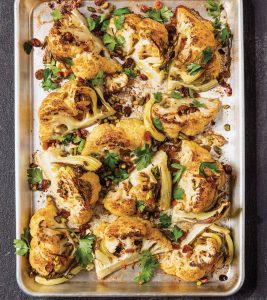 roasted cauliflower with pistachios and golden raisins. Basic roasted cauliflower was visually and flavorfully enhanced with a simple topper of pistachios, raisins, and parsley, “very good!” Sauteed asparagus with apricot and lemon sounded quite appealing (it was asparagus season, after all). The four cooks who made this deemed it “good” or “OK;” but all said they love asparagus so much that they prefer it roasted plain! Citrusy cumin-roasted carrots were just “OK.” The orange flavor was muted at best; it needed more orange or perhaps some lemon to punch it up?
roasted cauliflower with pistachios and golden raisins. Basic roasted cauliflower was visually and flavorfully enhanced with a simple topper of pistachios, raisins, and parsley, “very good!” Sauteed asparagus with apricot and lemon sounded quite appealing (it was asparagus season, after all). The four cooks who made this deemed it “good” or “OK;” but all said they love asparagus so much that they prefer it roasted plain! Citrusy cumin-roasted carrots were just “OK.” The orange flavor was muted at best; it needed more orange or perhaps some lemon to punch it up?
Once again, desserts got the short end of the stick; several of us thought many recipes looked enticing, but only one actually got made: 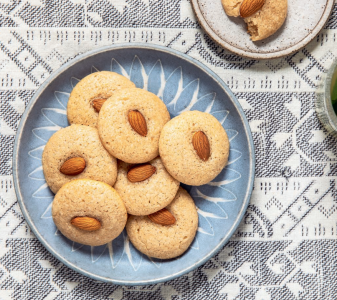 chewy Iraqi almond cookies. These were lovely, chewy cookies loaded with almond flavor; they’re gluten-free as they contain only almond flour. Though the recipe called for rose water (a common ingredient in Middle Eastern sweets) our cook left it out– this is an acquired taste for non-natives and some commented that so far, they don’t enjoy a floral note in their baked goods.
chewy Iraqi almond cookies. These were lovely, chewy cookies loaded with almond flavor; they’re gluten-free as they contain only almond flour. Though the recipe called for rose water (a common ingredient in Middle Eastern sweets) our cook left it out– this is an acquired taste for non-natives and some commented that so far, they don’t enjoy a floral note in their baked goods.
As you might surmise from the above, most of us focused on the Sephardic (or Middle Eastern) branch of Jewish cuisine, as opposed to the Ashkenic (or Eastern European) style. Perhaps, since it was springtime, no one was into making the heartier Ashkenazi food, and/or the flavors just sounded less appealing. Though we certainly had our successes, the overall reaction to this title was somewhat tepid. There was lots of “OK” or “pretty good” but not much that was deemed a keeper. A few of the recipes seemed “generic:” challah, tomato-cucumber salad, latkes. However, there’s lots of chatty information about Jewish culture and Shabbat in particular, so this could be of great interest depending on who you are/what you’re interested in learning about. As for the book itself, the photos were nicely done, though there were “not enough.” Are there ever? The font is quite small, which has become something of a trend, one that most of us don’t endorse!
So, though we definitely enjoy the ish factor in our cooking, this didn’t really turn out to be the one for our group. Accordingly, our rating averaged out to a 3.0 (out of a possible 5). That’s a pretty average average!
In June we’ll be sticking closer to home with Heather Atwood’s In Cod We Trust, all about “the celebrated cuisine of coastal Massachusetts.” Copies are available at the main circulation desk or via curbside pickup. Join us to discuss this title at our next meeting on Friday June 30 at 11 AM in the McCarthy Meeting Room. See you there!
*Perhaps it could be more accurately described as a pilaf or a gumbo, where ingredients are cohesive yet distinct? It’s telling that any way you slice it (!), it’s a food metaphor.
**Shabbat: “a day of rest and celebration that begins on Friday at sunset and ends on the following evening.” —chabad.org
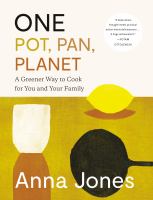
Bibliobites in April: One Pot, One Pan, One Book
 Sustainability: it’s a word and an idea that’s on everyone’s radar. But it’s such an all-encompassing concept that often it’s hard to figure out how we can and should apply it to different aspects of our lives. In the supermarket and in the kitchen, then, what does sustainable mean, and how would we incorporate such an approach into our cooking? This month’s title, One Pot, Pan, Planet by Anna Jones (our tie-in with this year’s One Book, Migrations by Charlotte McConaghy), provides a template for using less energy and fewer resources in our daily cooking. Less waste is certainly a desirable goal, but tasty meals are also important– so did we discover that you can have both?
Sustainability: it’s a word and an idea that’s on everyone’s radar. But it’s such an all-encompassing concept that often it’s hard to figure out how we can and should apply it to different aspects of our lives. In the supermarket and in the kitchen, then, what does sustainable mean, and how would we incorporate such an approach into our cooking? This month’s title, One Pot, Pan, Planet by Anna Jones (our tie-in with this year’s One Book, Migrations by Charlotte McConaghy), provides a template for using less energy and fewer resources in our daily cooking. Less waste is certainly a desirable goal, but tasty meals are also important– so did we discover that you can have both?
Unsurprisingly, this book contains only vegetarian recipes. Eating lower on the food chain reduces environmental impact, and costs less, too; no small consideration given the sharp increase in food prices over the last year. Most in our group are happy to discover new ways with beans, grains, or veggies, and the “one pot” concept always appeals! In fact, this book is arranged by cooking vessel (more on that later), whether pot, skillet, or sheet pan. The majority of recipes are either main dishes or close to that, needing only perhaps rice or bread to make a complete meal. Sturdy, reliable cauliflower had a star turn in many recipes: pan-roasted cauliflower with saffron butter was a huge hit with its herby yogurt sauce. Cooking the cauliflower in a cast iron pan gave it plenty of crispy brown bits, a perfect contrast to the silky sauce. Sticky sesame-baked cauliflower also had a super sauce, this one an addictive blend of salty soy sauce and sweet maple syrup. Chili paste added a nice kick. Two people made 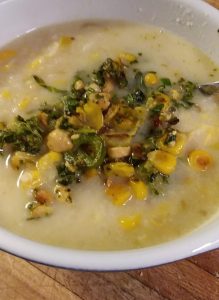 corn and cauliflower chowder, but for both it was a big disappointment. There was an excessive amount of corn in the chowder; its flavor and texture dominated unpleasantly. The saving grace was a zippy topper of sauteed peanuts, scallions, and chilis. Cauliflower was also played a strong supporting role in saag aloo shepherd’s pie. This well-spiced casserole of beans and tomatoes used mashed potatoes and cauliflower for a topper. Though this dish was “very good” and “looked just like the photo,” it was a bit of a project, even though it was in the “Quick” chapter.
corn and cauliflower chowder, but for both it was a big disappointment. There was an excessive amount of corn in the chowder; its flavor and texture dominated unpleasantly. The saving grace was a zippy topper of sauteed peanuts, scallions, and chilis. Cauliflower was also played a strong supporting role in saag aloo shepherd’s pie. This well-spiced casserole of beans and tomatoes used mashed potatoes and cauliflower for a topper. Though this dish was “very good” and “looked just like the photo,” it was a bit of a project, even though it was in the “Quick” chapter.
Stalwarts cabbage and carrots were also frequently featured: three people tried carrot and sesame pancakes (interestingly, these were really mostly cabbage!). These crispy fritters highlighted the classic soy/ginger combination, and were loaded with shredded veggies. Though the flavor and texture were excellent when first made, leftovers were a bust. No matter how they were reheated, they were on the dry side, and the cabbage became unpleasantly chewy. But, “I would try again, with wilted or sauteed (as opposed to raw) cabbage.” Roasted rainbow carrots with beans and salsa rustica made a fine main dish with the addition of some cooked farro; but the salsa, though quite good, required much chopping, “I liked this but it wasn’t worth the time.” Carrot and peanut nasi goreng was a pleasing bowl of fried rice, also featuring cabbage and tofu. Two people made this and thought it was a solid version of fried rice. The garnishes of cilantro, lime, and fried shallots definitely kicked it up a notch.
Tofu made several appearances in this book; though it had “a lot of ingredients,” flash-fried sticky tofu was “good!” with an appropriately sticky glaze. 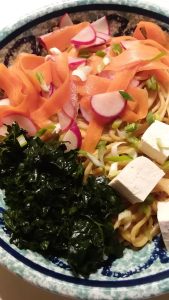 White miso ramen was a soupy bowl of goodness with its umami-loaded, creamy noodles paired with cooling tofu and crisp veggies. A keeper! We tried a few bean-centered casseroles: quick chickpea braise with kale and harissa was, in fact, quick; it was “very tasty….and a good leftover.” Baked dhal with tamarind-glazed sweet potatoes was “nice and creamy,” since the lentils were cooked in plant-based milk. The caramelized sweet potato topping added flavor and texture. On the negative side, lemon chickpea and green herb stew was “bland” and “lacked oomph;” despite a full can of coconut milk, our cook “couldn’t taste the coconut.” And quick squash lasagna was “relatively quick;” our cook liked the lentils in it though the dish as a whole had “too much squash.” Still, “I might make again!”
White miso ramen was a soupy bowl of goodness with its umami-loaded, creamy noodles paired with cooling tofu and crisp veggies. A keeper! We tried a few bean-centered casseroles: quick chickpea braise with kale and harissa was, in fact, quick; it was “very tasty….and a good leftover.” Baked dhal with tamarind-glazed sweet potatoes was “nice and creamy,” since the lentils were cooked in plant-based milk. The caramelized sweet potato topping added flavor and texture. On the negative side, lemon chickpea and green herb stew was “bland” and “lacked oomph;” despite a full can of coconut milk, our cook “couldn’t taste the coconut.” And quick squash lasagna was “relatively quick;” our cook liked the lentils in it though the dish as a whole had “too much squash.” Still, “I might make again!”
One aspect of this book that we all enjoyed was the “ten simple [name of veggie] ideas.” These two-page spreads provided quick and easy recipes for a vegetable you might have languishing in your crisper. Cheesy 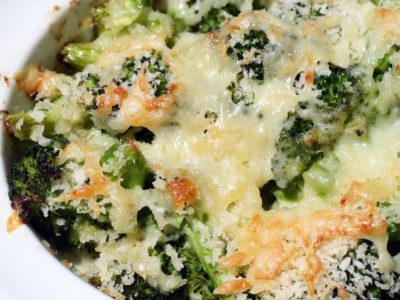 quick broccoli gratin was a hit from this section; it was delicious when first made and was a “really good leftover.” However, broccoli and sesame noodles did not make the grade; the “thin, bitter” sauce was “awful.” In looking at the recipe, the group thought perhaps the amount of vinegar called for overpowered the other flavors. Frittatas also came in for the simple, check-what’s-in-the-fridge treatment; our cook tried a combination of asparagus, cheese, and onion that was tasty enough. But, “it was better when I added some salami!” Despite the fact that salami is obviously not a vegetarian ingredient, it still fits into the premise of the book: use up what you have and don’t waste anything.
quick broccoli gratin was a hit from this section; it was delicious when first made and was a “really good leftover.” However, broccoli and sesame noodles did not make the grade; the “thin, bitter” sauce was “awful.” In looking at the recipe, the group thought perhaps the amount of vinegar called for overpowered the other flavors. Frittatas also came in for the simple, check-what’s-in-the-fridge treatment; our cook tried a combination of asparagus, cheese, and onion that was tasty enough. But, “it was better when I added some salami!” Despite the fact that salami is obviously not a vegetarian ingredient, it still fits into the premise of the book: use up what you have and don’t waste anything.
 There are only a few dessert recipes in this book, and though many of us had intentions to try something, only one person followed through with chocolate and almond butter swirl brownies. These were a rich and deeply chocolate riff on the classic chocolate/peanut butter combo. They were a bit crumbly, but no one who sampled these at our meeting had any complaints!
There are only a few dessert recipes in this book, and though many of us had intentions to try something, only one person followed through with chocolate and almond butter swirl brownies. These were a rich and deeply chocolate riff on the classic chocolate/peanut butter combo. They were a bit crumbly, but no one who sampled these at our meeting had any complaints!
This was an interesting title for most of us, for several reasons. First, the organization of the book (by cooking vessel) was either helpful or annoying, depending on how you’re approaching things at any given moment. Also, fairly often the “one pot” concept was a bit inaccurate. Maybe technically there was one pot or pan, but multiple bowls were needed to prep and organize. Or you had to cook one ingredient, remove it from the pan to a bowl or plate, then wipe out the pan to re-use. That doesn’t seem to be quite in the spirit of one-pot cooking! Also, despite the “sustainable” moniker, the author frequently uses expensive or less-available ingredients; perhaps all that cabbage just needs a little flavor boost? There are a lot of nuts and seeds in the recipes, which some can’t eat, and they are pricey. Other ingredients that were used a bit too often were soy sauce, chili oil, miso, and kale. All of these are delicious, but they did seem to make a few too many appearances.
The book itself and its photos also came in for discussion and criticism. Many were puzzled by and unimpressed with the extremely neutral color palette of the photos, as well as their spare design. It’s a definite look that might or might not appeal. The text is very small, with ingredient lists in the pale gray font which has become very common, and can be difficult to read, especially in combination with tiny text. There’s quite a lot of general and detailed information on more-sustainable food purchasing and cooking practices, which gave us some new ideas to digest, pun intended!
While we can certainly get on board with the author’s premise of shopping and cooking more mindfully, for most, strictly as a cookbook, this title just didn’t appeal and our rating reflects that: our votes averaged out to a 2.3 (out of a possible 5). That’s our lowest score in some time. Please join us for our next meeting on Friday, May 26 at 11 AM in the Fireplace Room, when we’ll be discussing Jew-ish: reinvented recipes from a modern mensch by Jake Cohen. If you think Jewish cuisine is only latkes and matzoh ball soup, you’re in for a surprise. For instance, try the tart, salty, spicy pomegranate-bbq chicken wings on page 61. Positively addictive! Copies are available at the main circulation desk or via curbside pickup.

Bibliobites in March: Showtime!
 It’s an embarrassment of visual riches when it comes to cooking. In addition to cookbooks with stunning, eat-off-the page photography, we have access to an almost limitless number of cooking shows, cooking competitions, and how-to cooking videos. Public television may have started the video revolution (thanks to Julia Child), but now cable channels, streaming services, YouTube and TikTok have all gotten in on the action. It’s become routine for cookbook authors and bloggers to star on the small screen, and it’s never been easier to binge our current obsession (I’m looking at you, British Baking Show!). Being (of course) on trend, this month our Bibliobites group traveled to video land. Each of us chose a book written by a current or former TV chef. Eight different chef/authors were put to the test; did their food taste as good as it looks?
It’s an embarrassment of visual riches when it comes to cooking. In addition to cookbooks with stunning, eat-off-the page photography, we have access to an almost limitless number of cooking shows, cooking competitions, and how-to cooking videos. Public television may have started the video revolution (thanks to Julia Child), but now cable channels, streaming services, YouTube and TikTok have all gotten in on the action. It’s become routine for cookbook authors and bloggers to star on the small screen, and it’s never been easier to binge our current obsession (I’m looking at you, British Baking Show!). Being (of course) on trend, this month our Bibliobites group traveled to video land. Each of us chose a book written by a current or former TV chef. Eight different chef/authors were put to the test; did their food taste as good as it looks?
 Many of the chef/authors we reviewed have had impressive staying power; for example, Ellie Krieger has been writing and on TV since the the early 2000s. Her mantra of “delicious meets healthy” obviously still resonates, and those in our group mostly enjoyed both Whole in One (her newest) and You Have It Made (2016).
Many of the chef/authors we reviewed have had impressive staying power; for example, Ellie Krieger has been writing and on TV since the the early 2000s. Her mantra of “delicious meets healthy” obviously still resonates, and those in our group mostly enjoyed both Whole in One (her newest) and You Have It Made (2016).  Ms. Krieger is “adept at including vegetables in a tasty way,” and most of her recipes are easy enough for a weeknight. Hits included Mexican chicken stew, turkey meatloaf, Sicilian chicken (featuring the addictive sweet/salty combo of olives and honey), and roasted tofu African peanut stew (the cinnamon in it was “yum!”). One semi-flop: macaroni and four cheeses; it had “too much pumpkin,” which dominated the entire dish. But, after a few days in the fridge, flavors melded and it tasted much better.
Ms. Krieger is “adept at including vegetables in a tasty way,” and most of her recipes are easy enough for a weeknight. Hits included Mexican chicken stew, turkey meatloaf, Sicilian chicken (featuring the addictive sweet/salty combo of olives and honey), and roasted tofu African peanut stew (the cinnamon in it was “yum!”). One semi-flop: macaroni and four cheeses; it had “too much pumpkin,” which dominated the entire dish. But, after a few days in the fridge, flavors melded and it tasted much better.
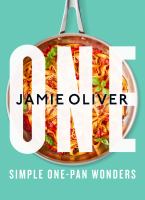
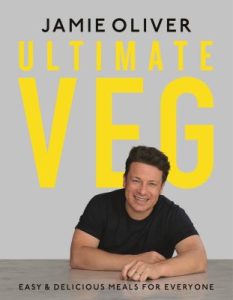 On this side of the pond, Brit Jamie Oliver has also been a longtime TV presence. We checked out two of his more recent titles, One: Simple One Pan Wonders and Ultimate Veg. Crispy pesto salmon was a solid choice with bold flavors. One oddity: the recipe called for canned potatoes! Greens mac and cheese was a happy combination of broccoli, spinach, and plenty of Cheddar. Overall comments included, “he has lots of good ideas,” “his pasta recipes are always good,” “liked nutrition info,” and “great photos!”
On this side of the pond, Brit Jamie Oliver has also been a longtime TV presence. We checked out two of his more recent titles, One: Simple One Pan Wonders and Ultimate Veg. Crispy pesto salmon was a solid choice with bold flavors. One oddity: the recipe called for canned potatoes! Greens mac and cheese was a happy combination of broccoli, spinach, and plenty of Cheddar. Overall comments included, “he has lots of good ideas,” “his pasta recipes are always good,” “liked nutrition info,” and “great photos!”
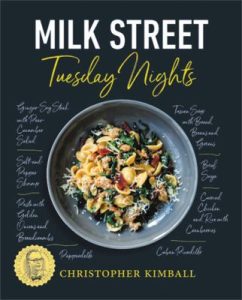 PBS fixture Christopher Kimball has written multiple titles since starting his Milk Street TV series; we tried out Milk Street Tuesday Nights and Cook What You Have. Neither title garnered much praise; so-so dishes included two cheese baked farro with kale and tomatoes (“flavors didn’t go, somehow”), and Vietnamese pork and scallion omelet, which featured ground pork (“too much pork!”) and fish sauce.
PBS fixture Christopher Kimball has written multiple titles since starting his Milk Street TV series; we tried out Milk Street Tuesday Nights and Cook What You Have. Neither title garnered much praise; so-so dishes included two cheese baked farro with kale and tomatoes (“flavors didn’t go, somehow”), and Vietnamese pork and scallion omelet, which featured ground pork (“too much pork!”) and fish sauce. 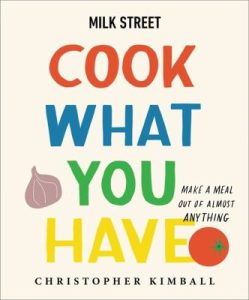 One complaint about Cook What You Have is that recipes included plenty of fresh ingredients, which aren’t normally considered pantry items. And of course, your pantry needs to be aligned with the author’s in order for the concept to work! Our cook did like the “have this, try that” feature, which provided much appreciated ideas for swapping ingredients.
One complaint about Cook What You Have is that recipes included plenty of fresh ingredients, which aren’t normally considered pantry items. And of course, your pantry needs to be aligned with the author’s in order for the concept to work! Our cook did like the “have this, try that” feature, which provided much appreciated ideas for swapping ingredients.
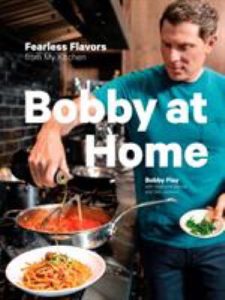 Bobby Flay seems to be perpetually on TV, and his “Beat Bobby Flay” show has become something of a cultural phenomenon. Our cook tried out Bobby at Home, which has “something for everyone….[food is] simple yet elevated.” Hits included the Mediterranean mezze platter, which included homemade pita chips, roasted jalapeno pesto (with parsley, walnuts, and garlic), and lemon hummus spread. Our group was able to sample this combination at our meeting, and it was super! Marinara sauce was “really simple and very good” with a nice pro tip: don’t bother cutting up your canned tomatoes before cooking; just mash in the pot after simmering softens them. Simple and effective. Unlike many of his TV peers, there are very few of Mr. Flay’s recipes online.
Bobby Flay seems to be perpetually on TV, and his “Beat Bobby Flay” show has become something of a cultural phenomenon. Our cook tried out Bobby at Home, which has “something for everyone….[food is] simple yet elevated.” Hits included the Mediterranean mezze platter, which included homemade pita chips, roasted jalapeno pesto (with parsley, walnuts, and garlic), and lemon hummus spread. Our group was able to sample this combination at our meeting, and it was super! Marinara sauce was “really simple and very good” with a nice pro tip: don’t bother cutting up your canned tomatoes before cooking; just mash in the pot after simmering softens them. Simple and effective. Unlike many of his TV peers, there are very few of Mr. Flay’s recipes online.
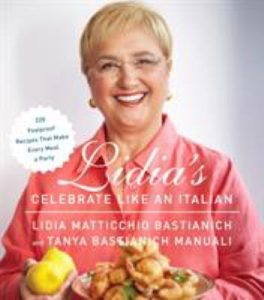
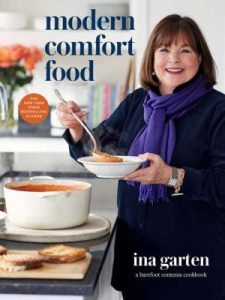 The prolific and energetic Lidia Bastianich always seems to have a new cookbook and companion TV show; one of her newest is Celebrate Like an Italian. But, two of our cooks turned to her many online recipes, and enjoyed rigatoni with sausage and escarole (“I love escarole!”) and skillet gratinate of summer tomato and pork. This family favorite (“I’ve made it a hundred times!”) can be easily and endlessly varied, the formula being pounded cutlets + thinly sliced veggies and/or sauce + cheese. Like Ms. Bastianich, Ina Garten enjoys a large and devoted following, and she shares the love by publishing most of her recipes on her website. Our group member checked out Modern Comfort Food and made truffled mac and cheese, a decadent combination of rich cheeses, earthy mushrooms, and umami-rich truffle butter. As might be expected, this was amazingly delicious, with a few caveats: white truffle butter is very expensive and tricky to source (“I did find truffle oil at TJMaxx….mixed it with butter”); and the recipe called for 2 tablespoons of salt. As has been noted by our group before, Ms. Garten has a very heavy hand with the salt! In the final analysis, “some of the recipes looked good, but I still wouldn’t buy it since a lot of recipes can be found online.”
The prolific and energetic Lidia Bastianich always seems to have a new cookbook and companion TV show; one of her newest is Celebrate Like an Italian. But, two of our cooks turned to her many online recipes, and enjoyed rigatoni with sausage and escarole (“I love escarole!”) and skillet gratinate of summer tomato and pork. This family favorite (“I’ve made it a hundred times!”) can be easily and endlessly varied, the formula being pounded cutlets + thinly sliced veggies and/or sauce + cheese. Like Ms. Bastianich, Ina Garten enjoys a large and devoted following, and she shares the love by publishing most of her recipes on her website. Our group member checked out Modern Comfort Food and made truffled mac and cheese, a decadent combination of rich cheeses, earthy mushrooms, and umami-rich truffle butter. As might be expected, this was amazingly delicious, with a few caveats: white truffle butter is very expensive and tricky to source (“I did find truffle oil at TJMaxx….mixed it with butter”); and the recipe called for 2 tablespoons of salt. As has been noted by our group before, Ms. Garten has a very heavy hand with the salt! In the final analysis, “some of the recipes looked good, but I still wouldn’t buy it since a lot of recipes can be found online.”
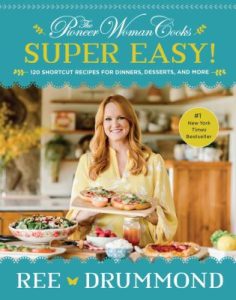 Ree Drummond, a.k.a. the Pioneer Woman, also has amazing staying power. With multiple cookbooks to her credit, a blog, and a TV show that’s been on for more than a decade, she’s carved out a unique niche in the food world. Her down-home cuisine and descriptions of life on a ranch in Oklahoma have endeared her to countless fans. However, The Pioneer Woman Cooks Super Easy just didn’t make the grade for our cook. Despite an abundance of “pretty pictures,” the recipes were unimpressive. Beef noodle skillet was “basic hamburger helper,” stir-fry with scallops had “lots of ingredients but not a lot of flavor.” Ms. Drummond’s “dump recipes,” which involve combining several cans of ingredients together, are indeed very easy; but as a result there was way too much salt, preservatives, and gummy stabilizers. One of the author’s claims to fame is her step-by-step photos, but these proved to be an annoyance, as the pictures are arranged vertically, and not in the conventional left-to-right orientation.
Ree Drummond, a.k.a. the Pioneer Woman, also has amazing staying power. With multiple cookbooks to her credit, a blog, and a TV show that’s been on for more than a decade, she’s carved out a unique niche in the food world. Her down-home cuisine and descriptions of life on a ranch in Oklahoma have endeared her to countless fans. However, The Pioneer Woman Cooks Super Easy just didn’t make the grade for our cook. Despite an abundance of “pretty pictures,” the recipes were unimpressive. Beef noodle skillet was “basic hamburger helper,” stir-fry with scallops had “lots of ingredients but not a lot of flavor.” Ms. Drummond’s “dump recipes,” which involve combining several cans of ingredients together, are indeed very easy; but as a result there was way too much salt, preservatives, and gummy stabilizers. One of the author’s claims to fame is her step-by-step photos, but these proved to be an annoyance, as the pictures are arranged vertically, and not in the conventional left-to-right orientation.
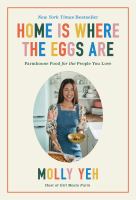 Blogger Molly Yeh has also found fame in a rural location: she writes and cooks on a farm in western Minnesota. Home Is Where the Eggs Are, her second book, continues the combination of Asian, Jewish, and Scandinavian influences for which she is known. Want peanut noodles with charred scallions, steak, and broccolini? You got it! How about chickpea tot hotdish? Or falafel turkey burgers (“those are the best!”)? Most of what’s in this book is easy comfort food that draws from diverse cultures, so it’s comfort food with some distinctive twists. The photogenic author is an irrepressibly sunny presence on the Food Network, and many recipes are available online.
Blogger Molly Yeh has also found fame in a rural location: she writes and cooks on a farm in western Minnesota. Home Is Where the Eggs Are, her second book, continues the combination of Asian, Jewish, and Scandinavian influences for which she is known. Want peanut noodles with charred scallions, steak, and broccolini? You got it! How about chickpea tot hotdish? Or falafel turkey burgers (“those are the best!”)? Most of what’s in this book is easy comfort food that draws from diverse cultures, so it’s comfort food with some distinctive twists. The photogenic author is an irrepressibly sunny presence on the Food Network, and many recipes are available online.
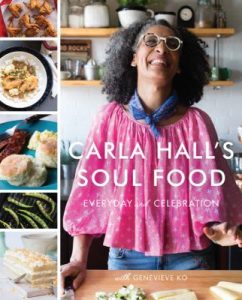 Chef and TV star Carla Hall hasn’t written that many cookbooks, but her latest, Carla Hall’s Soul Food, has made quite a splash and introduced many to the joys of its namesake African/Caribbean/Southern cuisine. At our meeting we sampled pimento cheese, that iconic Southern delight. This piquant, creamy cheese spread is good on just about anything, and is hard to stop eating. Though our cook started out with Ms. Hall’s recipe, she eventually concocted a mashup with Deb Perelman’s (of Smitten Kitchen fame), which features mashed potatoes (see below). But, any way you make it, it’s delicious! The chicken recipes in this book drew particular praise: brown sugar baked chicken and molasses baked chicken wings (nicely sticky with vinegar and garlic, in addition to the molasses) were both easy and flavorful.
Chef and TV star Carla Hall hasn’t written that many cookbooks, but her latest, Carla Hall’s Soul Food, has made quite a splash and introduced many to the joys of its namesake African/Caribbean/Southern cuisine. At our meeting we sampled pimento cheese, that iconic Southern delight. This piquant, creamy cheese spread is good on just about anything, and is hard to stop eating. Though our cook started out with Ms. Hall’s recipe, she eventually concocted a mashup with Deb Perelman’s (of Smitten Kitchen fame), which features mashed potatoes (see below). But, any way you make it, it’s delicious! The chicken recipes in this book drew particular praise: brown sugar baked chicken and molasses baked chicken wings (nicely sticky with vinegar and garlic, in addition to the molasses) were both easy and flavorful.
Most people enjoyed the book they used, though some felt the particular title they had didn’t measure up to the author’s other efforts. And though it’s a fairly meaningless statistic (given that we all used different titles), we voted anyway. Rather unsurprisingly, we averaged out to a very average 3.54 (out of a possible 5)! An average, of course, disguises a lot; ratings ranged from 2 to 5. Though we enjoyed our TV explore, this month we’ll all be cooking from the same book again: Anna Jones’ One Pot, Pan, Planet, a tie-in to this year’s One Book, Migrations by Charlotte McConaghy. Copies are available at the main circulation desk or via curbside pickup. Our next meeting will be on Friday, April 28 at 11 AM in the Fireplace Room. Hope to see you there!
Pimento Cheese (inspired by and adapted from Carla Hall and Deb Perelman)
1 red or yellow potato, approx. 4 oz.
1/4 cup drained, finely chopped pimento peppers
2-3 scallions, greens only, sliced
1/8 teaspoon celery salt (or to taste)
1/8 teaspoon cayenne (or to taste)
1 fat garlic clove, grated
4 oz. cream cheese, softened
8 oz. sharp Cheddar cheese, grated
Boil potato in unsalted water until soft; drain, cool, and peel. Mash potato and mix well with all ingredients except Cheddar, then slowly add Cheddar until evenly distributed.
Cover and refrigerate for at least 1 hour before serving to allow flavors to mellow and meld. Keeps in the fridge for one week, if it lasts that long!
Thanks to Lindsey S. for the recipe!
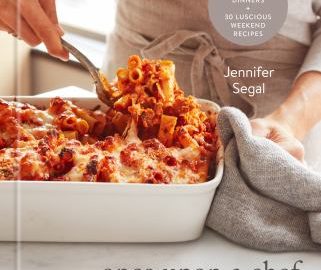
Bibliobites in February: Just. Really. Good.
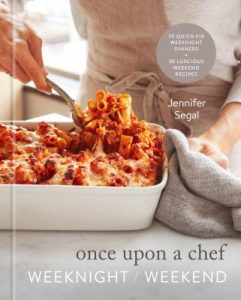 Every now and then our group takes on a title that hits a certain sweet spot: the recipes are familiar enough, but with some unexpected twists; the resulting dishes are high on the flavor meter and low on the effort scale; ingredients are easily located in your favorite supermarket; and most telling, you enjoy the book so much that you’re going to buy it. The last title to showcase all of these desirable attributes was Tieghan Gerard’s Half Baked Harvest Super Simple (reviewed in April 2022). But according to our group, we now have a worthy successor in February’s Once Upon a Chef: Weeknight/Weekend by Jennifer Segal. The conversation was fast and furious as we shared our tales of yumminess; my note-taking during our discussion was seriously impaired by the speed of our conversation. Mostly I wound up writing down “really good” way too many times; hence the title of this post!
Every now and then our group takes on a title that hits a certain sweet spot: the recipes are familiar enough, but with some unexpected twists; the resulting dishes are high on the flavor meter and low on the effort scale; ingredients are easily located in your favorite supermarket; and most telling, you enjoy the book so much that you’re going to buy it. The last title to showcase all of these desirable attributes was Tieghan Gerard’s Half Baked Harvest Super Simple (reviewed in April 2022). But according to our group, we now have a worthy successor in February’s Once Upon a Chef: Weeknight/Weekend by Jennifer Segal. The conversation was fast and furious as we shared our tales of yumminess; my note-taking during our discussion was seriously impaired by the speed of our conversation. Mostly I wound up writing down “really good” way too many times; hence the title of this post!
As you might guess from the book’s title, Ms. Segal covers quicker, simpler recipes for weeknights, as well as some projects you might want to try on a weekend, or whenever you have more time. There are chapters on desserts and sides, but the bulk of the book is focused on what’s for dinner. Accordingly, most of us made main dishes. One of the first “weeknight” chapters covers soup, always a popular choice in winter. Six people made 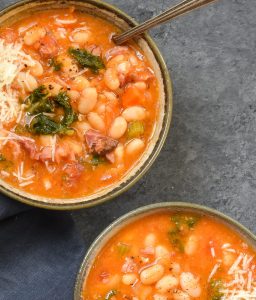 smoky chickpea, red lentil, and vegetable soup. This soup was a big hit for most; hearty red lentils played deliciously with smoked paprika, while chickpeas and veggies rounded out the bowl. Pumpkin leek soup was a quick and tasty combination of mostly pantry ingredients, starring canned pumpkin. Apples and leeks added complexity, while cayenne provided a welcome touch of heat. Creamy potato soup was “great for a cold night” with its loaded baked potato garnishes of sour cream, chives, and cheddar. Lasagna soup also riffed on a classic, though not quite as successfully; it was only “pretty good” though “I would make again.” In the “weekend” section of the book, Italian wedding soup turned out to be a keeper; the meatballs in particular were “so good!” The whole soup was deemed “really good!” And since it was winter, we only made one main-dish salad: soba chicken noodle salad. Though it didn’t make a great leftover, “I would definitely recommend.” The dressing oozed umami with notes of soy, sesame, ginger, and peanut, which perfectly complemented the salad ingredients.
smoky chickpea, red lentil, and vegetable soup. This soup was a big hit for most; hearty red lentils played deliciously with smoked paprika, while chickpeas and veggies rounded out the bowl. Pumpkin leek soup was a quick and tasty combination of mostly pantry ingredients, starring canned pumpkin. Apples and leeks added complexity, while cayenne provided a welcome touch of heat. Creamy potato soup was “great for a cold night” with its loaded baked potato garnishes of sour cream, chives, and cheddar. Lasagna soup also riffed on a classic, though not quite as successfully; it was only “pretty good” though “I would make again.” In the “weekend” section of the book, Italian wedding soup turned out to be a keeper; the meatballs in particular were “so good!” The whole soup was deemed “really good!” And since it was winter, we only made one main-dish salad: soba chicken noodle salad. Though it didn’t make a great leftover, “I would definitely recommend.” The dressing oozed umami with notes of soy, sesame, ginger, and peanut, which perfectly complemented the salad ingredients.
Moving on to all things fishy, chipotle shrimp and poblano quesadillas scored points for using mostly ingredients you’d likely have on hand; the result was cheesy and nicely spicy with “…a bit of a kick!” Drunken style noodles also featured shrimp; this classic Thai noodle dish was fragrant with Thai basil (sourced at an Asian market) and loaded with veggies and shrimp. It “made a ton,” but didn’t make a good leftover, “the noodles don’t hold up well.” Another shrimpy hit, Greek-style shrimp with tomatoes and feta (“love it!”), showcased bold flavors and a refreshing accent of mint. Bonus: if you have an ovenproof skillet, it’s a one-pot meal. Linguine with shellfish, tomatoes, and saffron was “delicious!” If you love mussels, this one’s for you, with plenty of flavor from the briny shellfish, garlic, saffron, and anchovies. In finfish territory, salmon got a workout: two people made everyday spice crusted salmon, a solid if not outstanding choice. The spice crust was a version of everything bagel seasoning, which lately seems to be showing up on….everything! 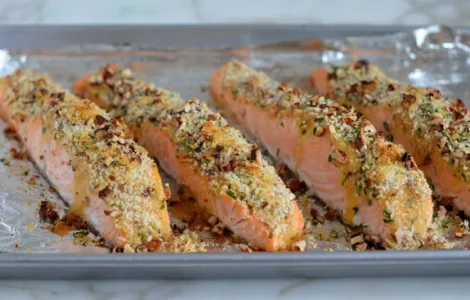 Baked salmon with honey mustard and pecan-panko crust was deemed “excellent” by the three who made it. The mustard came in for high praise, as did the pecans, “loved everything about it!” Miso and soy marinated black cod sounded enticing, but the “balance [of the marinade] was off….the sesame was too strong.” But if you love sesame, this could be the fish dish for you. A more delicate fish recipe, pan-seared halibut with beurre blanc was “yummy!” though it had “too much sauce.” Is that possible? And classic blackened fish tacos delivered with a nice combo of spice and toppers. This dish, while easy enough, had several components, so maybe not the best choice for a frazzled weeknight!
Baked salmon with honey mustard and pecan-panko crust was deemed “excellent” by the three who made it. The mustard came in for high praise, as did the pecans, “loved everything about it!” Miso and soy marinated black cod sounded enticing, but the “balance [of the marinade] was off….the sesame was too strong.” But if you love sesame, this could be the fish dish for you. A more delicate fish recipe, pan-seared halibut with beurre blanc was “yummy!” though it had “too much sauce.” Is that possible? And classic blackened fish tacos delivered with a nice combo of spice and toppers. This dish, while easy enough, had several components, so maybe not the best choice for a frazzled weeknight!
On to meaty doings: oddly, we didn’t seem to make as much chicken as usual, though all of the recipes we did try were definite winners. Barbecued soy and ginger chicken thighs were super on the grill (taking advantage of an unusually warm day); the accompanying cucumber salad was “awesome!” Two chicken dishes on the richer side were equally delicious, creamy dijon chicken and butter-style chicken. Both used chicken tenders, so everything came together quickly. 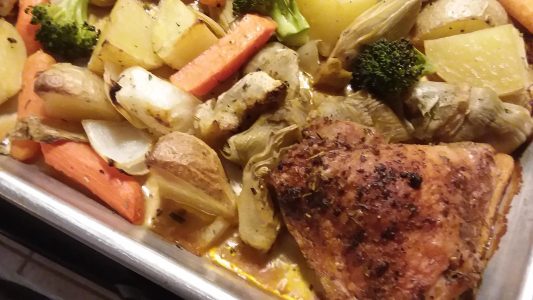 Sheet pan roast chicken with artichokes, potatoes, carrots, and peas was a true one-pan meal, with herbes de Provence as the dominant seasoning. This dish was easy to put together, and it made an excellent leftover. A keeper! Staying with poultry, there’s a whole chapter on meatballs; three people made turkey, spinach, and cheese meatballs. Our cooks liked the spinach in them, and that they “made a lot….[and were] nice and moist!” However, they “needed more sauce.” Sheet pan chicken and pancetta meatballs kicked it up a notch with salty, porky pancetta in the meatballs, and a tomato-balsamic glaze on top. Baking all the meatballs in one go kept it easy. We made a few beef dishes, too: both bulgogi-style flank steak skewers and flat iron carne asada were solid choices, and were deemed (see title of post, above) “really good!” Three people tried out “blog fave” five-star beef stew. This “weekend” recipe made the grade, “easy and very good….gravy so nice and thick,” though one person thought it was “good– but no better than most.” Like most classic beef stews, this recipe used plenty of red wine and lots of simmering time to build flavor. And, as you might expect, it aged well in the fridge.
Sheet pan roast chicken with artichokes, potatoes, carrots, and peas was a true one-pan meal, with herbes de Provence as the dominant seasoning. This dish was easy to put together, and it made an excellent leftover. A keeper! Staying with poultry, there’s a whole chapter on meatballs; three people made turkey, spinach, and cheese meatballs. Our cooks liked the spinach in them, and that they “made a lot….[and were] nice and moist!” However, they “needed more sauce.” Sheet pan chicken and pancetta meatballs kicked it up a notch with salty, porky pancetta in the meatballs, and a tomato-balsamic glaze on top. Baking all the meatballs in one go kept it easy. We made a few beef dishes, too: both bulgogi-style flank steak skewers and flat iron carne asada were solid choices, and were deemed (see title of post, above) “really good!” Three people tried out “blog fave” five-star beef stew. This “weekend” recipe made the grade, “easy and very good….gravy so nice and thick,” though one person thought it was “good– but no better than most.” Like most classic beef stews, this recipe used plenty of red wine and lots of simmering time to build flavor. And, as you might expect, it aged well in the fridge.
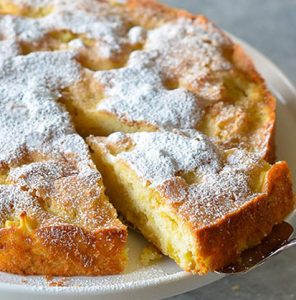 And last, we arrive at dessert; at our meeting we sampled French apple cake, which three of us made! This simple cake was addictive, with a few tablespoons of rum in the batter that added a certain je ne sais quoi. It didn’t taste alcoholic at all, but the liquor was the perfect accent for the apples and tender cake. We also liked that it made only one small layer, and was a one-bowl cake. A keeper! Brownie pudding was another keeper. This first cousin of chocolate lava cake was rich and buttery, yet light and delicate. Since there’s only one-third cup of flour in the recipe, the chocolate and butter really sing. And it’s easy to turn into a gluten-free dessert. At our meeting we also sampled another chocolate treat, sour cream chocolate loaf cake. This was “really easy” and “really good” (there’s that phrase again!). The cake was pleasantly dense in that poundcake-y way, and instant espresso in the batter added oomph.
And last, we arrive at dessert; at our meeting we sampled French apple cake, which three of us made! This simple cake was addictive, with a few tablespoons of rum in the batter that added a certain je ne sais quoi. It didn’t taste alcoholic at all, but the liquor was the perfect accent for the apples and tender cake. We also liked that it made only one small layer, and was a one-bowl cake. A keeper! Brownie pudding was another keeper. This first cousin of chocolate lava cake was rich and buttery, yet light and delicate. Since there’s only one-third cup of flour in the recipe, the chocolate and butter really sing. And it’s easy to turn into a gluten-free dessert. At our meeting we also sampled another chocolate treat, sour cream chocolate loaf cake. This was “really easy” and “really good” (there’s that phrase again!). The cake was pleasantly dense in that poundcake-y way, and instant espresso in the batter added oomph.
Phew! Along with discussing our massive amounts of cooking, group members praised the book itself. The plentiful full-page photos made the food look incredibly enticing; and even better, our efforts usually looked just like the photo. That, to us, indicated that the recipes had been thoroughly tested. This consistency made us feel more confident that our efforts would be rewarded with deliciousness, and they almost always were. Though (amazingly) no one complained about it, there are fairly copious headnotes, and the recipe instructions are printed in a small and thin gray font. But perhaps no one even noticed these petty flaws because they were too busy cooking, eating, and enjoying the author’s food. So, as you might expect, this book was highly rated by our group: we averaged out to 4.39 (out of 5). Three people planned to buy the book!
Please join us for our next meeting on Friday, March 31 at 11 AM in the Fireplace Room. This month, it’s Food Network Festival! Choose a book from a selected cart of titles at the main circulation desk, all featuring well-known TV chefs. See you on the 31st!
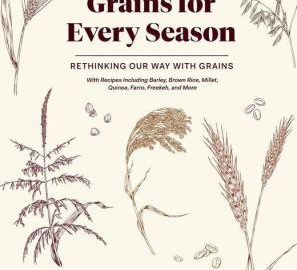
Bibliobites in January: Going with the Grain
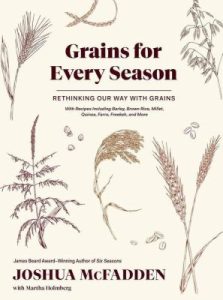 This January was a grainy month. To start with, the weather was unusually, depressingly, gray and rainy; and with a little funky math, gray + rainy = grainy! More to the point, our Bibliobites group tackled Grains For Every Season by author and restauranteur Joshua McFadden. The author’s first book, Six Seasons: A New Way with Vegetables, is an award-winning tome showcasing fresh, seasonal vegetables in simple, innovative ways. Did this sophomore effort live up to the first? And perhaps more importantly, did we find new ways with familiar grains, and/or new grains to love?
This January was a grainy month. To start with, the weather was unusually, depressingly, gray and rainy; and with a little funky math, gray + rainy = grainy! More to the point, our Bibliobites group tackled Grains For Every Season by author and restauranteur Joshua McFadden. The author’s first book, Six Seasons: A New Way with Vegetables, is an award-winning tome showcasing fresh, seasonal vegetables in simple, innovative ways. Did this sophomore effort live up to the first? And perhaps more importantly, did we find new ways with familiar grains, and/or new grains to love?
Eating whole grains isn’t a remotely recent idea; as the author points out, grains have sustained humanity for untold centuries. Though some grains may not yet be familiar to Americans, new awareness of grains’ healthfulness, versatility, and satisfying flavors has led to greater availability, and therefore more widespread use. McFadden aims to keep us moving in that inclusive direction, using familiar grains and flours in new ways, and using less-common grains in traditional dishes (for example, using farro to make “risotto”). In addition to recipes, this title is a treatise of sorts on the botany of grains, how they’re grown and processed, and how best to cook and store them. This information was overkill for some, but others enjoyed the in-depth background. Trying out those new grains sometimes required a bit of shopping around, either to a natural foods store or online. However, a surprising number were available at local supermarkets. Each chapter of the book highlights a particular grain, and includes a mixed bag of recipes, from appetizers to desserts.
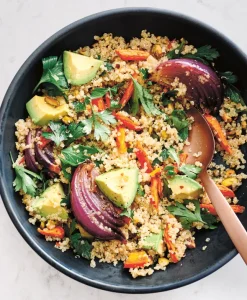 New-age darling quinoa was featured in roasted carrot, avocado, pistachio, and quinoa salad. This was a hit for both people who tried it; it was a harmonious combination of “ingredients that I love.” And the pistachios added welcome crunch. Quinoa also appeared in super grain and veggie burgers, along with rolled oats, barley, chickpeas, and more. As the author notes, with all those ingredients the burgers are a bit of a project; but the recipe makes 12 and they freeze well. Mushrooms and garlic added plenty of savory depth; carrots provided a bit of sweetness. By happenstance or design, the burgers are vegan, which meant eggs weren’t used as a binder; and this was problematic. Even though they tended to fall apart, they were “a really good veggie burger….I would make again.”
New-age darling quinoa was featured in roasted carrot, avocado, pistachio, and quinoa salad. This was a hit for both people who tried it; it was a harmonious combination of “ingredients that I love.” And the pistachios added welcome crunch. Quinoa also appeared in super grain and veggie burgers, along with rolled oats, barley, chickpeas, and more. As the author notes, with all those ingredients the burgers are a bit of a project; but the recipe makes 12 and they freeze well. Mushrooms and garlic added plenty of savory depth; carrots provided a bit of sweetness. By happenstance or design, the burgers are vegan, which meant eggs weren’t used as a binder; and this was problematic. Even though they tended to fall apart, they were “a really good veggie burger….I would make again.”
Freekeh, a form of wheat that’s harvested while still green, was one of the grains that was less available locally (Whole Foods carries it). Our cook used it in freekeh falafel, where unfortunately, “the freekeh didn’t blend in as well [as I would have liked].” The accompanying spicy creamy green sauce was a hit, though. But, “I still like the traditional style better.” A form of wheat with which we’re all very familiar, whole wheat flour, was baked into whole wheat pitas. These were easy to make and went well with the aforementioned falafel, though they were a bit too salty. Whole wheat foccaccia was something of a project, requiring two overnight risings, but it was worth the effort, “really tasty…the [1/4 cup] rye flour added a certain je ne sais quoi.” Note to purists: this recipe is more than half white flour, though the author encourages you to play with the proportions. 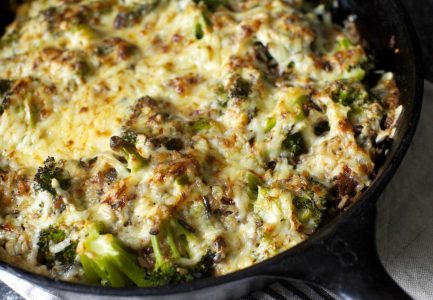 Broccoli, tuna, and wheat berry gratin used wheat in its least-processed form, wheat berries. This riff on ’50s tuna noodle casserole was a huge hit, just “really good!” There were a couple of minor issues: the wheat berries needed to cook longer than the recipe indicated, and the broccoli needed to be cooked a bit less!
Broccoli, tuna, and wheat berry gratin used wheat in its least-processed form, wheat berries. This riff on ’50s tuna noodle casserole was a huge hit, just “really good!” There were a couple of minor issues: the wheat berries needed to cook longer than the recipe indicated, and the broccoli needed to be cooked a bit less!
Winter fave barley had its moment, appearing in the veggie burgers above, and in lightly curried lamb, cabbage, and barley soup. This soup had a “beautiful” broth, and the combination of lamb and cabbage was “so good!” The barley added nice heft, always welcome on a cold day. One caveat: lamb shanks are no longer an inexpensive choice! Farro, another form of wheat that has a similar flavor and texture as barley, made for a wonderful farrotto in the style of cacio e pepe. This risotto clone was peppery and cheesy in the best possible way, a bowl of nourishing comfort food for a chilly winter night. Like risotto, there was a fair amount of stirring involved, but on the whole it was simple to make.
That ’70s favorite, brown rice, is still popular today, and for good reason. It’s tasty, inexpensive, and available everywhere. Semi-traditional 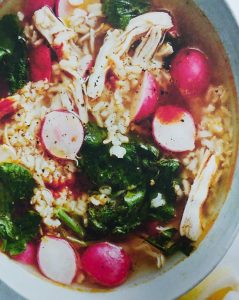 chicken soup with brown rice, radishes, and lots of lemon was a lighter take on chicken soup. If you have cooked chicken on hand, this soup was quick to assemble, and the simmered radishes in it were “a nice twist.” Toasted brown rice horchata was a dairy-free version of this cooling Mexican drink; it was “very sweet and very good.” Though not essential, it’s helpful if you have a nut milk bag for this recipe, an item not widely available. Wild rice with chicken, broccoli, bok choy, and garlic-chile crunch featured brown rice’s fancier and more expensive cousin, wild rice. This was a savory one-pot meal loaded with satisfying Asian flavors, but it “needed more rice.” Perhaps the author was trying to go easy on our food budgets!
chicken soup with brown rice, radishes, and lots of lemon was a lighter take on chicken soup. If you have cooked chicken on hand, this soup was quick to assemble, and the simmered radishes in it were “a nice twist.” Toasted brown rice horchata was a dairy-free version of this cooling Mexican drink; it was “very sweet and very good.” Though not essential, it’s helpful if you have a nut milk bag for this recipe, an item not widely available. Wild rice with chicken, broccoli, bok choy, and garlic-chile crunch featured brown rice’s fancier and more expensive cousin, wild rice. This was a savory one-pot meal loaded with satisfying Asian flavors, but it “needed more rice.” Perhaps the author was trying to go easy on our food budgets!
Traditional oats starred in no-bake chocolate-coated oat, date, and cashew bars. These bars were chewy and a bit crumbly, with plenty of nutty and chocolate flavor. And they froze well, always a plus. Rye has recently become a popular partner for chocolate; here it was used in 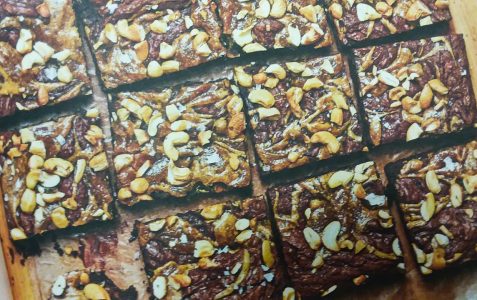 chocolate rye brownies with cashew swirl. These were “super fancy brownies” with a prominent cashew flavor. The rye wasn’t evident at all, but no matter– these were a rich and delicious version of brownies. On a more savory note, rye caraway crackers showcased a classic pairing; “I liked the strong flavors.” The dough was somewhat sticky, which made it hard to roll out the crackers thinly, but these were worth trying again.
chocolate rye brownies with cashew swirl. These were “super fancy brownies” with a prominent cashew flavor. The rye wasn’t evident at all, but no matter– these were a rich and delicious version of brownies. On a more savory note, rye caraway crackers showcased a classic pairing; “I liked the strong flavors.” The dough was somewhat sticky, which made it hard to roll out the crackers thinly, but these were worth trying again.
Most of us have probably only used buckwheat as flour, and our group was no exception. Buckwheat crackers “weren’t bad…a bit bland.” Much better were buckwheat cream scones your way; these were a huge hit for both people who made them. The scones were rich yet light with a delicate buckwheat flavor, and as the recipe title indicates, you could customize them to your liking. One person added dried cherries and chocolate chips; another embellished with blueberries and a lemon glaze. A keeper! The less common version of buckwheat, groats (or kasha) appeared in buckwheat, lime, and herb salad, larb style. This vegetarian riff on a popular Thai dish didn’t make the grade– the amount of fish sauce was overpowering, and the buckwheat flavor didn’t come through. We only tried one recipe with bulgur, but it was a winner: spiced beef and bulgur hand pies. Though it was a bit of work to make the individual turnovers, the filling was “delicious….enhanced by all the spices.” if you don’t want to deal with the crust, “the filling would be great all by itself!” Sounds like another keeper.
In the back of the book, McFadden includes a chapter he calls “Go-Tos,” recipes for various condiments, sauces, and toppings. One person loved the brined and roasted almonds, which had fantastic “really good salty flavor.” 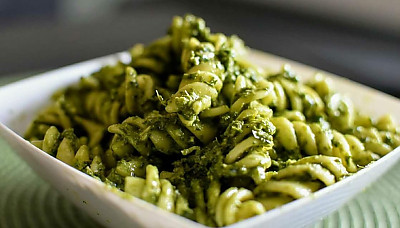 Updated kale sauce for pasta or grains is a newer version of a popular recipe from Six Seasons; this was a beautiful deep green color and was pesto-like with garlic and Parmesan cheese. Unfortunately the garlic flavor became overpowering after the sauce sat in the fridge for a few days, and unless you have a powerful blender, the texture will be somewhat stringy, rather than smooth.
Updated kale sauce for pasta or grains is a newer version of a popular recipe from Six Seasons; this was a beautiful deep green color and was pesto-like with garlic and Parmesan cheese. Unfortunately the garlic flavor became overpowering after the sauce sat in the fridge for a few days, and unless you have a powerful blender, the texture will be somewhat stringy, rather than smooth.
In general, this book seemed rather hit or miss for most of the group. Some couldn’t work up any enthusiasm for this book; nothing called to them. For others, as evidenced above, there were at least a few keepers, and several “almosts.” Some thought the author was trying too hard to include grains in everything, and some just didn’t care for his combinations and/or seasonings. Our overall ambivalence was reflected in our voting: we averaged out to a 2.75 (out of a possible 5). Is that close to a passing grade?
Please join us for our next meeting on Friday, February 24 at 11 AM in the Fireplace Room. We’ll be discussing another sophomore effort, Once Upon a Chef Weeknight/Weekend by chef and blogger Jennifer Segal. Copies are available at the main circulation desk or via curbside pickup. See you there!
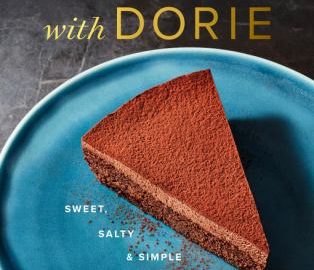
Bibliobites in November/December: Another Dorie Story
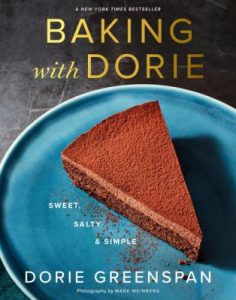 Author Dorie Greenspan is a one-woman cookbook industry. Over the past thirty years she’s written fourteen cookbooks, won five James Beard Awards for them (and was nominated eleven times!), and endeared herself to countless readers who adore her warm, friendly personality as much as her warm, buttery baked goods. Our group has been in Dorie territory before: we baked Dorie’s Cookies in December 2019, and cooked our way through Everyday Dorie in January 2021. This month’s title, Baking With Dorie, is her newest, and promises recipes that are “sweet, salty, and simple.” This book received rave reviews when it was released, and continues to receive gushing praise from reviewers and users of every stripe, so expectations were high. How did it go for us in the kitchen?
Author Dorie Greenspan is a one-woman cookbook industry. Over the past thirty years she’s written fourteen cookbooks, won five James Beard Awards for them (and was nominated eleven times!), and endeared herself to countless readers who adore her warm, friendly personality as much as her warm, buttery baked goods. Our group has been in Dorie territory before: we baked Dorie’s Cookies in December 2019, and cooked our way through Everyday Dorie in January 2021. This month’s title, Baking With Dorie, is her newest, and promises recipes that are “sweet, salty, and simple.” This book received rave reviews when it was released, and continues to receive gushing praise from reviewers and users of every stripe, so expectations were high. How did it go for us in the kitchen?
Though most members of our group consider themselves cooks rather than bakers, everyone approached this month’s challenge with gusto (or at least a lot of butter and sugar!). The first chapter covers breakfast bakes, so let’s start there: one person, an experienced bread baker, made english muffins. This version was “better than some” and the dough was easy to work with. The recipe contained lots of helpful information for any novice muffin makers. 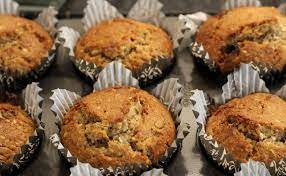 Two people made grain and seed muffins, a “really delicious,” not-too-sweet, hearty combination of whole wheat flour, seeds, and raisins. Fruit and nuts were also featured in pecan cranberry loaf. The pecans were “the star….loved them.” But there could have definitely been more cranberries. Iced honey apple scones with spelt sounded divine, with orange, apple, and honey playing starring roles; but somehow they were “a bit boring.” And they weren’t as flaky as our baker might have wished. On the sweeter side of breakfast, breakfast in rome lemon cake had that classic and delightful flavor combination of lemon and raspberry. It was “very poundcake-y” and kept well. Unfortunately, despite the thick batter, the raspberries sank to the bottom of the pan, a sadly common problem!
Two people made grain and seed muffins, a “really delicious,” not-too-sweet, hearty combination of whole wheat flour, seeds, and raisins. Fruit and nuts were also featured in pecan cranberry loaf. The pecans were “the star….loved them.” But there could have definitely been more cranberries. Iced honey apple scones with spelt sounded divine, with orange, apple, and honey playing starring roles; but somehow they were “a bit boring.” And they weren’t as flaky as our baker might have wished. On the sweeter side of breakfast, breakfast in rome lemon cake had that classic and delightful flavor combination of lemon and raspberry. It was “very poundcake-y” and kept well. Unfortunately, despite the thick batter, the raspberries sank to the bottom of the pan, a sadly common problem!
And speaking of cakes, mocha walnut torte was a “huge hit.” This incidentally gluten-free treat was wonderfully fudgy when cold, and had beautiful chocolate flavor accented by ground espresso. Cranberry spice squares weren’t as impressive; they were “good….nothing special.” But they did showcase “nice warm spices.” Also featuring a “nice mild spice taste,”  swirled spiced sour cream bundt cake was “very tasty….spice went well with the chocolate.” On the downside, the half-cup of sugar in the swirl made the cake stick stubbornly to the pan. Though steph’s bakewell tart appears in the pie chapter, it’s really more of a cake, or perhaps a mashup of the two. This classic British treat is swoon-worthy: a rich, sweet, and tart combination of crust, jam, and tender almond cake. We can only hope that Dorie’s recipe brings it the attention it deserves on this side of the pond. Szarlotka appears in the pie chapter too, and this torte is also a combination of cake and crust. The torte is filled with apples and has a crumble topping; it was tasty although the apples never did get quite tender, despite over an hour in the oven! The method for this dessert was also somewhat cumbersome and convoluted, “I have a recipe for something similar that is much easier and that I like better.”
swirled spiced sour cream bundt cake was “very tasty….spice went well with the chocolate.” On the downside, the half-cup of sugar in the swirl made the cake stick stubbornly to the pan. Though steph’s bakewell tart appears in the pie chapter, it’s really more of a cake, or perhaps a mashup of the two. This classic British treat is swoon-worthy: a rich, sweet, and tart combination of crust, jam, and tender almond cake. We can only hope that Dorie’s recipe brings it the attention it deserves on this side of the pond. Szarlotka appears in the pie chapter too, and this torte is also a combination of cake and crust. The torte is filled with apples and has a crumble topping; it was tasty although the apples never did get quite tender, despite over an hour in the oven! The method for this dessert was also somewhat cumbersome and convoluted, “I have a recipe for something similar that is much easier and that I like better.”
Ms. Greenspan is known for her cookies, and these were a popular choice for many in the group. Cocoa caramel biscotti were a big “thumbs up.” The simple chocolate glaze was the perfect accent. Probably one of the simplest recipes in the book, brown sugar oat squares were a caramelly, toothsome combination of ground oats and brown sugar, and were, as advertised, “easy and fast.” Two people baked olive oil brownies which were “rich but not dense,” although “[I wasn’t] sure about the raisins.” Neither the olive oil nor the half-teaspoon of black pepper were very obvious in the finished product, but it was still a good, if not outstanding, version of brownies.  Iced spiced hermits were soft, pleasantly chewy, and spiced with the usual suspects of cinnamon, ginger, and nutmeg (and black pepper!). This traditional New England cookie features dried fruit, and sometimes includes nuts, though this version doesn’t. The recipe made plenty, so fortunately they kept well. Devil’s thumbprints were a chocolate variation of thumbprint cookies; our baker filled the indentations with ganache, “I would make again!” The timing seemed off on this recipe; it definitely “needed more” time in the oven. And mokonuts’ rye cranberry chocolate chunk cookies were a delicious and unusual combination of rye flour, dried cranberries, chocolate, and poppy seeds. These were sweet, tart, chewy, and chocolatey all in one go. A keeper!
Iced spiced hermits were soft, pleasantly chewy, and spiced with the usual suspects of cinnamon, ginger, and nutmeg (and black pepper!). This traditional New England cookie features dried fruit, and sometimes includes nuts, though this version doesn’t. The recipe made plenty, so fortunately they kept well. Devil’s thumbprints were a chocolate variation of thumbprint cookies; our baker filled the indentations with ganache, “I would make again!” The timing seemed off on this recipe; it definitely “needed more” time in the oven. And mokonuts’ rye cranberry chocolate chunk cookies were a delicious and unusual combination of rye flour, dried cranberries, chocolate, and poppy seeds. These were sweet, tart, chewy, and chocolatey all in one go. A keeper!
The “salty” chapter of the book covers savory bakes, and we checked out some of those recipes as well. Cheese puffers, a riff on popovers, were “very easy….really good.” The optional mustard powder really kicked it up a notch and moved these puffs into keeper territory. Two people made 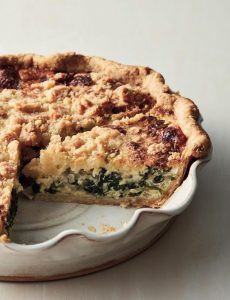 spinach mozzarella pie with parm crumble, which was a hit for both. It was “very easy” and tasty. The crumble topping in particular garnered high praise. Another tart, free style mushroom, herb and ricotta tart was a bit less successful. The onion-y ricotta and mushroom topping was savory and delicious; but the crust was completely flat, so the toppings weren’t well contained. And it made a poor leftover, since the ricotta’s moisture made the crust mushy. But this would be a great appetizer for a group; its cracker vibe seemed tailor-made for people to break off pieces at will. Whip it up quick cornbread was “fantastic” with all of its optional add-ins (bacon, jalapeno, cheese, scallions, herbs); it was “a meal in itself.” Sounds like a keeper! Another quick bread, goat cheese black pepper quick bread also hit the spot with its nuggets of creamy cheese and assertive black pepper. The chopped fresh mint added a bright herbal note, making for a lovely snack or pre-dinner nibble.
spinach mozzarella pie with parm crumble, which was a hit for both. It was “very easy” and tasty. The crumble topping in particular garnered high praise. Another tart, free style mushroom, herb and ricotta tart was a bit less successful. The onion-y ricotta and mushroom topping was savory and delicious; but the crust was completely flat, so the toppings weren’t well contained. And it made a poor leftover, since the ricotta’s moisture made the crust mushy. But this would be a great appetizer for a group; its cracker vibe seemed tailor-made for people to break off pieces at will. Whip it up quick cornbread was “fantastic” with all of its optional add-ins (bacon, jalapeno, cheese, scallions, herbs); it was “a meal in itself.” Sounds like a keeper! Another quick bread, goat cheese black pepper quick bread also hit the spot with its nuggets of creamy cheese and assertive black pepper. The chopped fresh mint added a bright herbal note, making for a lovely snack or pre-dinner nibble.
As is true of other Dorie Greenspan books, this one is overall a solid choice. The recipes and the book itself have obviously been crafted with care, and the author’s voice comes through loud and clear in her warm and amusing headnotes. The book has top-notch production values, with heavy, glossy paper and copious, drool-worthy photos. A few complaints were voiced: the ingredient lists were in too-small print; some recipes had overly complicated methods; too many recipes contained nuts; and it might have been nice to provide total prep times. The positives, though, generally outweighed the negatives, which was reflected in our group rating of 3.77 (out of a possible 5).
Please join us for our next meeting on Friday, January 27 at 11 AM in the Fireplace Room. We’ll be discussing our adventures with Grains For Every Season by Joshua McFadden. Copies are available at the main circulation desk or via curbside pickup. See you then, and Happy New Year to all!
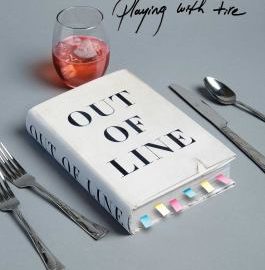
Bibliobites in October: True Grit
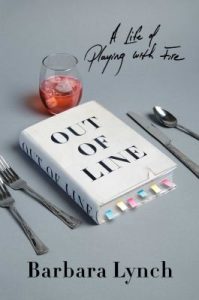 Recipe for a Boston chef: take one chaotic upbringing, add several crazy adrenaline-fueled teenage escapades, a pinch of caution, and a spoonful of insecurity. Stir in heaps of fierce determination and on-the-job learning. Work all ingredients together 24/7 for about eight to ten years, then bake in a hot, hot oven until it all flames out, or…. it all comes together and you produce James Beard Award winner and local chef and entrepreneur Barbara Lynch.
Recipe for a Boston chef: take one chaotic upbringing, add several crazy adrenaline-fueled teenage escapades, a pinch of caution, and a spoonful of insecurity. Stir in heaps of fierce determination and on-the-job learning. Work all ingredients together 24/7 for about eight to ten years, then bake in a hot, hot oven until it all flames out, or…. it all comes together and you produce James Beard Award winner and local chef and entrepreneur Barbara Lynch.
There are lots of memoirs written by chefs and restaurant workers of all stripes, and our Bibliobites group has certainly gone down that path before. Our October title, Out of Line, fits within the genre, but unapologetically breaks the mold as well. Ms. Lynch’s path to prominence in her chosen field is unique, and there was plenty to discuss, beginning with her early life in South Boston. Ms. Lynch grew up in Southie in an era when Southie was the stereotypical clannish enclave with which many of us are familiar. As the second youngest of seven being raised by a single mom in a housing project, she had little supervision and used her freedom in many risky ways. Some of her exploits were pretty shocking, like the time she and some friends briefly stole an MBTA bus. Somehow, she managed to stay out of jail long enough to discover a passion for cooking in a high school home ec class. We were all impressed by the teacher who mentored her and gave her life direction.
 Needless to say, Ms. Lynch’s path to prominence in her field wasn’t a traditional one. As one person commented, “she became successful despite it all.” She learned to cook in restaurants by doing, and by taking on challenges that most wouldn’t dare to try; for instance, talking her way into a job on a dinner-cruise ship where she had to feed 150 people by herself. It was hard for us to wrap our minds around the idea that she would do this with no training and minimal experience, and even more amazingly, pull it off. We thought that maybe “she had innate ability,” and it was true that “she had a lot of help” from friends and mentors. Still, her ability to learn fast and work incredibly hard were impressive. Since she never went to culinary school, she learned by observation, by doing, and by reading books, which was also remarkable, “how did she learn all that from books??” Hey, books rule!
Needless to say, Ms. Lynch’s path to prominence in her field wasn’t a traditional one. As one person commented, “she became successful despite it all.” She learned to cook in restaurants by doing, and by taking on challenges that most wouldn’t dare to try; for instance, talking her way into a job on a dinner-cruise ship where she had to feed 150 people by herself. It was hard for us to wrap our minds around the idea that she would do this with no training and minimal experience, and even more amazingly, pull it off. We thought that maybe “she had innate ability,” and it was true that “she had a lot of help” from friends and mentors. Still, her ability to learn fast and work incredibly hard were impressive. Since she never went to culinary school, she learned by observation, by doing, and by reading books, which was also remarkable, “how did she learn all that from books??” Hey, books rule!
In addition to being a highly regarded chef, Ms. Lynch is also a successful entrepreneur, with seven restaurants of various types, all located in downtown Boston. We admired her business acumen (again, learned on the job!), and the fact that “she treated her employees well.” For us suburban types, it’s worth noting that Ms. Lynch has bought a Gloucester landmark called The Rudder, which is set to open soon.
We admired Ms. Lynch’s overwhelming honesty about her life; her personality absolutely leaps off the page. “She’s very intense, like a lot of chefs.” “She is her own society…doesn’t care what others think.” “She had to act a certain way in order to survive and be safe.” A few in our group just plain didn’t like her, though they appreciated her accomplishments. Some disliked her writing; it was “too stream of consciousness” and “scattered.” The author admittedly has ADHD, so perhaps it’s not a surprise that sometimes she “jumped around” in her telling. And, a few people conceded that memoir isn’t their favorite genre, anyway!
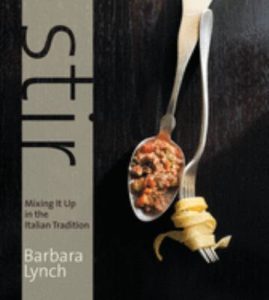 Ms. Lynch writes beautifully about food, and of course mentions numerous dishes she created in her restaurants, so we paired the memoir with her one cookbook, Stir. This was published in 2009 and contains several of her signature recipes from her first restaurant, No. 9 Park. Many of these recipes are fairly time-consuming projects (suitable for a rainy or snowy weekend!), but a few people took on the challenge. The book itself is beautiful, with an extra-large format and art-level photography, all on heavy, glossy paper. Definitely a coffee table-worthy tome! In the kitchen, though, opinions varied. One person was unimpressed; there was “nothing new” and it was “fancied-up basics…no spices…she relies on technique and extremely high quality ingredients.” But, poulet au pain was at least “super easy,” while spinach amandine was “like a light creamed spinach….it was fine.” Roasted winter squash with maple syrup and sage cream was enhanced by the sage cream, a nice, and slightly different, treatment. On the other hand, another cook who already “loves her (the author’s) food” enjoyed being able to make some of Ms. Lynch’s iconic dishes. Taleggio stuffed prosciutto-wrapped chicken (with fish fillets subbing for the chicken) was “so good” with its creamy cheese and tarragon accent. Lamb stew with sweet potatoes and barley was “the best…a keeper!” This stew was “pretty easy” though expensive; it had several different spices, so there was “a lot going on!” Pork chops with caramelized apples, celery, and spiced walnuts were “delicious;” and “I felt chef-y….it was fun; simple, easy.” The quick celery salad atop the chops was a fresh, welcome twist. And speaking of salads, B&G coleslaw was a winner; the lemon and Dijon mustard-accented dressing, “…. is now my go-to for coleslaw!” Sounds like a keeper.
Ms. Lynch writes beautifully about food, and of course mentions numerous dishes she created in her restaurants, so we paired the memoir with her one cookbook, Stir. This was published in 2009 and contains several of her signature recipes from her first restaurant, No. 9 Park. Many of these recipes are fairly time-consuming projects (suitable for a rainy or snowy weekend!), but a few people took on the challenge. The book itself is beautiful, with an extra-large format and art-level photography, all on heavy, glossy paper. Definitely a coffee table-worthy tome! In the kitchen, though, opinions varied. One person was unimpressed; there was “nothing new” and it was “fancied-up basics…no spices…she relies on technique and extremely high quality ingredients.” But, poulet au pain was at least “super easy,” while spinach amandine was “like a light creamed spinach….it was fine.” Roasted winter squash with maple syrup and sage cream was enhanced by the sage cream, a nice, and slightly different, treatment. On the other hand, another cook who already “loves her (the author’s) food” enjoyed being able to make some of Ms. Lynch’s iconic dishes. Taleggio stuffed prosciutto-wrapped chicken (with fish fillets subbing for the chicken) was “so good” with its creamy cheese and tarragon accent. Lamb stew with sweet potatoes and barley was “the best…a keeper!” This stew was “pretty easy” though expensive; it had several different spices, so there was “a lot going on!” Pork chops with caramelized apples, celery, and spiced walnuts were “delicious;” and “I felt chef-y….it was fun; simple, easy.” The quick celery salad atop the chops was a fresh, welcome twist. And speaking of salads, B&G coleslaw was a winner; the lemon and Dijon mustard-accented dressing, “…. is now my go-to for coleslaw!” Sounds like a keeper.
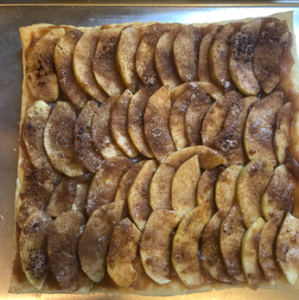 One person turned to the dessert section and made homemade apple butter tart, which we happily sampled at our meeting. This was yummy with lots of sweet and tart apple flavor from sliced apples and apple butter, but our cook mentioned that the recipe’s timing was off (it needed significantly more than called for), and the instruction to cover the tart in the oven with another baking sheet proved problematic; the top “wouldn’t cook!” And the kitchen torch, used to caramelize the apples, “made a mess.” At least a mess is better than a fire!
One person turned to the dessert section and made homemade apple butter tart, which we happily sampled at our meeting. This was yummy with lots of sweet and tart apple flavor from sliced apples and apple butter, but our cook mentioned that the recipe’s timing was off (it needed significantly more than called for), and the instruction to cover the tart in the oven with another baking sheet proved problematic; the top “wouldn’t cook!” And the kitchen torch, used to caramelize the apples, “made a mess.” At least a mess is better than a fire!
One of our conclusions about Stir was that recipes, techniques, and ideas that were revelatory in 2009 are pedestrian today. For instance, the idea of using super-fresh, local ingredients is a given now in restaurants and at farm stands, but 13 years ago that wasn’t so common. Some recipes that were new and exciting then (like the author’s signature gnocchi) can now be found in any decent mid-range restaurant. Still, there’s much that’s fun to peruse, and I personally plan to try out those gnocchi, as well as her iconic Bolognese sauce, sometime this winter when I need a diversion.
When we voted, the cookbook averaged out to a 2.5, and the memoir a 3.5 (out of a possible 5). Both scores disguise the fact that most votes were strongly on one end or the other, so your results may vary!
We will next meet on Friday, December 9 at 11 AM in the Fireplace Room, please note that this is a combined November/December meeting. We’ll be discussing Dorie Greenspan’s latest, Baking With Dorie. Copies are available at the main circulation desk or via curbside pickup. Hope to see you there!
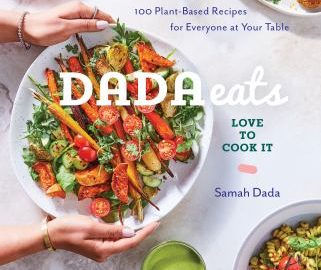
Bibliobites in September: Legume Love, Tahini Trysts
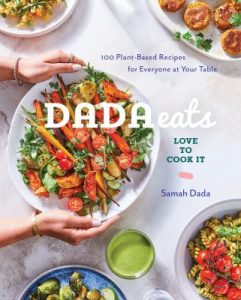 We’re back! After a summer hiatus, our Bibliobites group met, in person (!), on a sunny September morning. It was wonderful to welcome members new and old, and catch up with those we’d lost touch with over the past few years. And we were eager to discuss this month’s title, Dada Eats Love to Cook It by blogger, TV star, and Instagram darling Samah Dada. The photogenic author has built a following among the many (her Instagram has 266,000 followers) who adore her particular mix of recipes: plant-ish, healthy-ish, and Indian-ish. Ms. Dada was new to us; and though we’ve been down both vegan and Indian roads before, what did we think of this author’s version?
We’re back! After a summer hiatus, our Bibliobites group met, in person (!), on a sunny September morning. It was wonderful to welcome members new and old, and catch up with those we’d lost touch with over the past few years. And we were eager to discuss this month’s title, Dada Eats Love to Cook It by blogger, TV star, and Instagram darling Samah Dada. The photogenic author has built a following among the many (her Instagram has 266,000 followers) who adore her particular mix of recipes: plant-ish, healthy-ish, and Indian-ish. Ms. Dada was new to us; and though we’ve been down both vegan and Indian roads before, what did we think of this author’s version?
The book itself is the typical large format that seems to now be the standard; and there are lovely, appealing photos of most recipes. There are also many (too many for some) photos featuring the author, which seems to be especially prevalent in cookbooks produced by bloggers– perhaps readers like to see an author they’ve come to know as a person as well as a cook. Hence the also-common practice of including personal essays and/or extensive headnotes. Some loathe this trend, others embrace it; but for now it’s here to stay. One noticeable quirk of the photography: there are several photos highlighting the author’s beautiful, perfectly manicured hands! The majority of recipes fit on one page, no mean feat when you consider that precious space is taken up by those longish headnotes. Though no one in the group complained about it, the print is tiny. That helps to get everything on one page, but does make for more squinting. Other general negatives: we wished overall recipe times had been stated up front; and directions were sometimes overly verbose.
On to the important part: what did we eat?? Ms. Dada’s book covers breakfast, snacks, main dishes and desserts; but as usual most of us focused on the mains. There was lots of lentil and chickpea love going on; among the hits were the best dal ever, “really good, phenomenal!” Another dal, dal makhani, with black lentils and creamy coconut milk, was equally delicious. 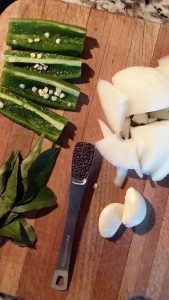 Dal saag was a flavorful blend of lentils, tomatoes, and spinach accented by plenty of spice and lemon. Sesame crusted lentil falafel also hit the spot with its yummy lemon-tahini sauce, and “it looked just like the photo!” Two people tried the classic chana masala; one wasn’t overly impressed, but for another it was “out of this world…such depth of flavors!” Chickpea patties were a tasty and fairly quick first cousin of falafel, with some nice crunch from their topping of fennel and cumin seeds.
Dal saag was a flavorful blend of lentils, tomatoes, and spinach accented by plenty of spice and lemon. Sesame crusted lentil falafel also hit the spot with its yummy lemon-tahini sauce, and “it looked just like the photo!” Two people tried the classic chana masala; one wasn’t overly impressed, but for another it was “out of this world…such depth of flavors!” Chickpea patties were a tasty and fairly quick first cousin of falafel, with some nice crunch from their topping of fennel and cumin seeds.
From the pasta chapter, lentil bolognese was almost a favorite; our cook liked the concept but felt it needed tweaking. As in, it actually needed more lentils! But all in all this was a hearty complement for pasta that was quick and easy to make from standard pantry ingredients. Spaghetti aglio e olio 2.0 was also a riff on a classic pasta dish; this iteration included roasted cauliflower (our cook used broccoli) and kale. The roasted veggies added welcome depth, and the kale was a nice twist, too. On the downside, it “needed more salt,” a problem easily corrected. Two pasta dishes highlighted eggplant: plot twist all’ Arrabbiata and 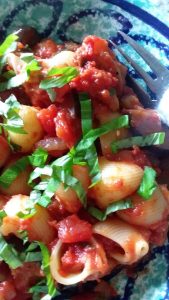 the unforgettable spicy tomato pasta. These two were so similar that one could easily have been just a variation of the other. The eggplant is pureed for the Arrabbiata sauce, and thinly sliced for the spicy tomato pasta, but otherwise they were virtually identical in their components and flavor profile: spicy, tomato-y, and garlicky. Both were solid choices and easy to make. If you like your pasta in a salad, turmeric-tahini pasta salad was a keeper, with “lots of flavor!” The mix of spices perfectly complemented the pasta, chickpeas, and kale. Tahini dressing tied it all together.
the unforgettable spicy tomato pasta. These two were so similar that one could easily have been just a variation of the other. The eggplant is pureed for the Arrabbiata sauce, and thinly sliced for the spicy tomato pasta, but otherwise they were virtually identical in their components and flavor profile: spicy, tomato-y, and garlicky. Both were solid choices and easy to make. If you like your pasta in a salad, turmeric-tahini pasta salad was a keeper, with “lots of flavor!” The mix of spices perfectly complemented the pasta, chickpeas, and kale. Tahini dressing tied it all together.
Though veggies certainly are given their due in the main dishes, there’s also a chapter devoted to salads, and one to vegetable sides. Hits included the crunchy creamy carrot salad (pictured on the book’s cover), with sweet roasted carrots and spicy arugula; and chilled chaat masala chickpea salad, which was “refreshing! easy!” Turmeric- roasted cauliflower was a winner with its cool and creamy cilantro-tahini sauce, and turmeric provided appealing sunny yellow color to the normally pasty cauliflower. Kale and romaine za’atar caesar salad “wasn’t really a caesar salad,” though it was pleasing in its own way with “really good” croutons and za’atar-accented dressing. One definite flop: baingan bharta, a traditional Indian dish of stewed eggplant and tomato, which produced “mushy eggplant.”
Since chickpeas were ubiquitous in this book, two people made pesto hummus. This was an easily made, garlicky spread that we enjoyed sampling at our meeting. In fact several group members noted that homemade hummus (of any variety) is very simple to make, and so much fresher than anything from a supermarket. 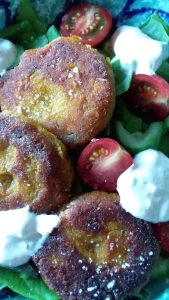 Another delicious success was sweet potato aloo tiki. These were tasty little patties made from sweet potatoes, pan-fried and served with a slightly spicy yogurt sauce. The cool, creamy sauce was the perfect foil for the hot, crispy patties. Though this recipe was in the appetizer section, they made a fine dinner. One caveat: they didn’t reheat all that well.
Another delicious success was sweet potato aloo tiki. These were tasty little patties made from sweet potatoes, pan-fried and served with a slightly spicy yogurt sauce. The cool, creamy sauce was the perfect foil for the hot, crispy patties. Though this recipe was in the appetizer section, they made a fine dinner. One caveat: they didn’t reheat all that well.
For the bakers in our group, there was plenty to choose from. Date caramel fudge brownies had a dense, gooey texture that was “really good!” The dates were a bit difficult to puree, but other than that the recipe was as quick as any other brownie recipe. Many of the baked goods in this book utilize coconut oil, and in these brownies the flavor was detectable– so if you don’t like coconut, you’ll need to make a substitution. Salted peanut butter caramel bars made an appearance at our meeting; these were a rich layered treat of shortbread crust, peanut butter filling, and chocolate topping. We couldn’t taste the coconut oil in these, perhaps because there were so many other yummy competing flavors! Pretzel tahini cookies were a satisfying, almost savory cookie. Almond flour made them soft and tender; pretzels added a nice crunch and a hit of salt. If you want to bake for breakfast, you could try rice crispy granola. This addictive blend featured lots of nuts, seeds, and almond butter. The addition of crispy rice cereal nicely lightened the mix. A second granola recipe, maple and olive oil tahini granola, didn’t use the crispy rice cereal, but was otherwise so similar that it was essentially a variation of the first recipe. Either would be a welcome way to start the day. 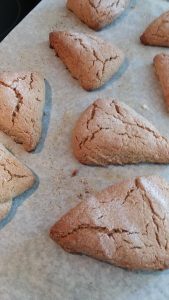 Honey tahini scones were perfectly flavored with their namesake ingredients, but they suffered texturally from using only oat flour, which made them very crumbly and gave them a pasty mouthfeel. Still, they were good enough that, “I will try again.”
Honey tahini scones were perfectly flavored with their namesake ingredients, but they suffered texturally from using only oat flour, which made them very crumbly and gave them a pasty mouthfeel. Still, they were good enough that, “I will try again.”
This title has a pretty well-defined flavor profile (lots of cumin, turmeric, cilantro, cayenne), and some ingredients are used repeatedly (chickpeas, lentils, tahini– I think I went through an entire jar of tahini in the month we used this book). Those were limiting factors for some. We certainly enjoyed many of the author’s vegetable-centric combinations, and it was fun (if somewhat expensive) to experiment with non-wheat flours and various sweeteners. But, the narrow-ish range of flavors made for a book we’d use less often than others. So despite our successes, our rating reflected a bit of ambivalence; we averaged out to a 2.9 (out of a possible 5).
Our next meeting will be on October 28 at 11 AM in the Fireplace Room. We’ll be discussing local restauranteur Barbara Lynch’s memoir, Out of Line. If you want to try your hand at some of Ms. Lynch’s iconic dishes, you can also pick up a copy of her one cookbook, Stir. Both are available at the main circulation desk or via curbside pickup. See you then!
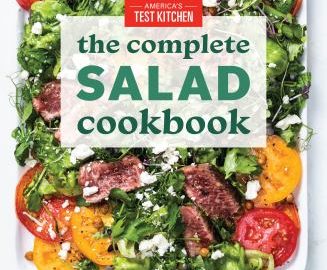
Bibliobites in June: Those Lazy, Hazy, Crazy Days of…. Salad!
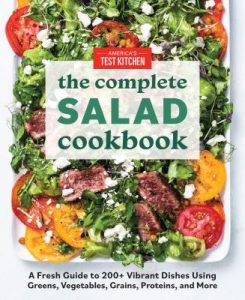 For many of us, salads equal summertime. In the winter, we may be happy to hunker down with steaming bowls of soup or sturdy casseroles, but when warmer weather (finally) arrives, we’re more likely to crave something lighter. A cool, crunchy main-dish salad can be the perfect dinnertime solution– substantial without being too heavy, refreshing, and uncomplicated to prepare. As a bonus, salad components can often be made ahead, and may not require much (if any cooking)– because wouldn’t you rather be at the beach instead of standing in front of the stove? This month our Bibliobites group gave their salad bowls a workout with The Complete Salad Cookbook from America’s Test Kitchen.
For many of us, salads equal summertime. In the winter, we may be happy to hunker down with steaming bowls of soup or sturdy casseroles, but when warmer weather (finally) arrives, we’re more likely to crave something lighter. A cool, crunchy main-dish salad can be the perfect dinnertime solution– substantial without being too heavy, refreshing, and uncomplicated to prepare. As a bonus, salad components can often be made ahead, and may not require much (if any cooking)– because wouldn’t you rather be at the beach instead of standing in front of the stove? This month our Bibliobites group gave their salad bowls a workout with The Complete Salad Cookbook from America’s Test Kitchen.
As is the norm for ATK titles, the subject of salads is given a thorough discussion. There’s lots of general information about ingredients and equipment, and comprehensive (some would say absurdly detailed) headnotes for each recipe. It’s a pretty hefty squarish tome, printed on thick, glossy paper; and there are inviting full-page photos of most recipes. But, no matter how fabulous the photos are, what really matters is the yumminess factor– so how did it go in the kitchen?
Most of us focused on main-dish salads; if you’re going to go to the trouble of chopping/cooking/assembling multiple ingredients and making a dressing from scratch, it might as well be dinner. But, we did make a few side-dish salads: tangy cabbage-apple slaw was a simple, quick, yet flavorful take on this summertime classic. Tangy, fruity cider vinegar and red pepper flakes really kicked it up a notch, and as a bonus, it kept quite happily in the fridge for more than a week. Recipes for Sichuan smashed cucumber salad, or 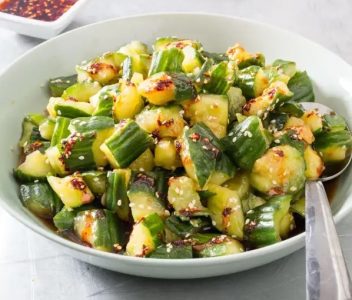 pai huang ga, have proliferated in books and on blogs; ATK’s version was “very fresh and light.” It was a good, simple side that also kept “better than expected,” considering that the main ingredient is intentionally bruised. And, caesar green bean salad was a “tasty” riff on the popular salad, if “a bit too mustardy.”
pai huang ga, have proliferated in books and on blogs; ATK’s version was “very fresh and light.” It was a good, simple side that also kept “better than expected,” considering that the main ingredient is intentionally bruised. And, caesar green bean salad was a “tasty” riff on the popular salad, if “a bit too mustardy.”
When we moved on to main dishes, there was a multitude of choices. Lentils were featured in spiced lentil salad with butternut squash which was “a good combination….but too much vinegar for me.” However, for another person, lentil salad with spinach, walnuts and parmesan hit the right notes with its similarly assertive vinegary tang. Garlic and shallot were the perfect complements in this simple dish. Black-eyed pea salad with pecans and peaches was a winner that we were lucky enough to taste at our post-meeting potluck. This was a tasty and colorful combination of creamy beans, sweet and tart peaches, and spicy arugula. Marinated cauliflower and chickpea salad had all the makings of a keeper, with its veggies and beans complemented with Spanish-leaning flavors of lemon, smoked paprika, and saffron. However the recipe also called for 3 tablespoons of sugar, which was an “unpleasant,” overly-prominent flavor in the finished dish. Another Spanish-y chickpea salad was much more successful: pearl couscous salad with chickpeas, chorizo, and warm spices was “a keeper!” Neutral couscous and nutty chickpeas were nicely balanced with spicy chorizo, raisins, and a simple lemon juice and olive oil dressing. Two people tried 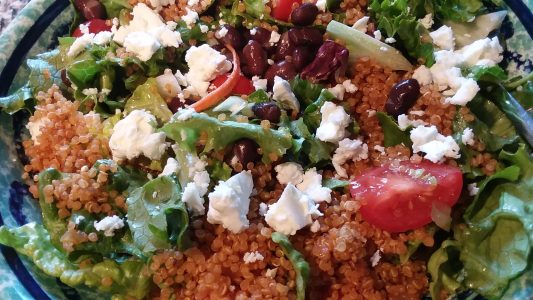 quinoa taco salad; one person didn’t care for the quinoa’s chipotle flavor, but for another it was just right. Both thought this was a good vegetarian version of taco salad; it had all the usual bells and whistles (avocado, tomato, queso fresco), while the quinoa and black beans provided heft. And, “it kept well.” Southwestern black bean salad also highlighted Mexican flavors of lime, chipotle, and cilantro; the result was “delicious…had a little kick!”
quinoa taco salad; one person didn’t care for the quinoa’s chipotle flavor, but for another it was just right. Both thought this was a good vegetarian version of taco salad; it had all the usual bells and whistles (avocado, tomato, queso fresco), while the quinoa and black beans provided heft. And, “it kept well.” Southwestern black bean salad also highlighted Mexican flavors of lime, chipotle, and cilantro; the result was “delicious…had a little kick!”
Noodle salads were a popular choice for our group; in addition to the pearl couscous salad above, one cook made sesame lo mein salad. This was “good– but I have other recipes that are better.” The cucumbers in it were a pleasant, refreshing addition. Peanut noodle salad was also “similar to others;” it was “a bit too sweet, but I did use less hot sauce” which may have thrown off the flavor balance. Crunchy bell peppers and cucumbers were cooling additions.
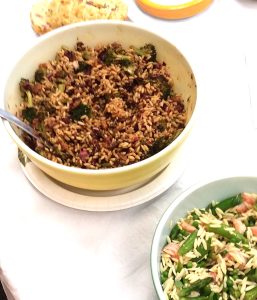
Orzo salad with broccoli and radicchio showcased savory Italian flavors with pine nuts, sun-dried tomatoes, and plenty of Parmesan. Unfortunately its bright colors faded significantly after a day in the fridge, so it’s not the best make-ahead dish.
Since this was our last meeting until September, we finished up with a potluck lunch featuring several of the salads mentioned above, as well as a highly praised mascarpone cheesecake from one of Joanne Chang’s books. Thanks to everyone for their delicious contributions!

Though we had a second title for this month (Food52 Mighty Salads), no one had used it. Some of us had paged through it, and thought it seemed a bit more involved than we wanted. Overall there was less cooking going on than usual; June is often a hectic month, and some members confessed they were still busy working their way through April’s selection, Half Baked Harvest Super Simple. That’s high praise indeed! Our voting for this month’s title averaged out to a 3.75 (out of a possible 5); the general consensus was, as one person put it: “….it was OK, very comprehensive but not innovative.” But, it’s a great way to start building your salad repertoire, should you need ideas.
Thank you to everyone for your participation this year, through all the ups and downs with which the pandemic has so generously gifted us. Your comments, opinions, and expertise are always enjoyed and appreciated. I look forward to our next meeting on Friday, September 30 at 11 AM. Have a wonderful summer!





